The document outlines the syllabus for the Programming in C course at Prathyusha Engineering College, covering objectives, course structure, unit topics, outcomes, and references. Key areas include basics of C programming, arrays and strings, functions and pointers, structures and unions, and file processing. Upon completion, students are expected to demonstrate knowledge of C programming constructs and develop various applications using C.
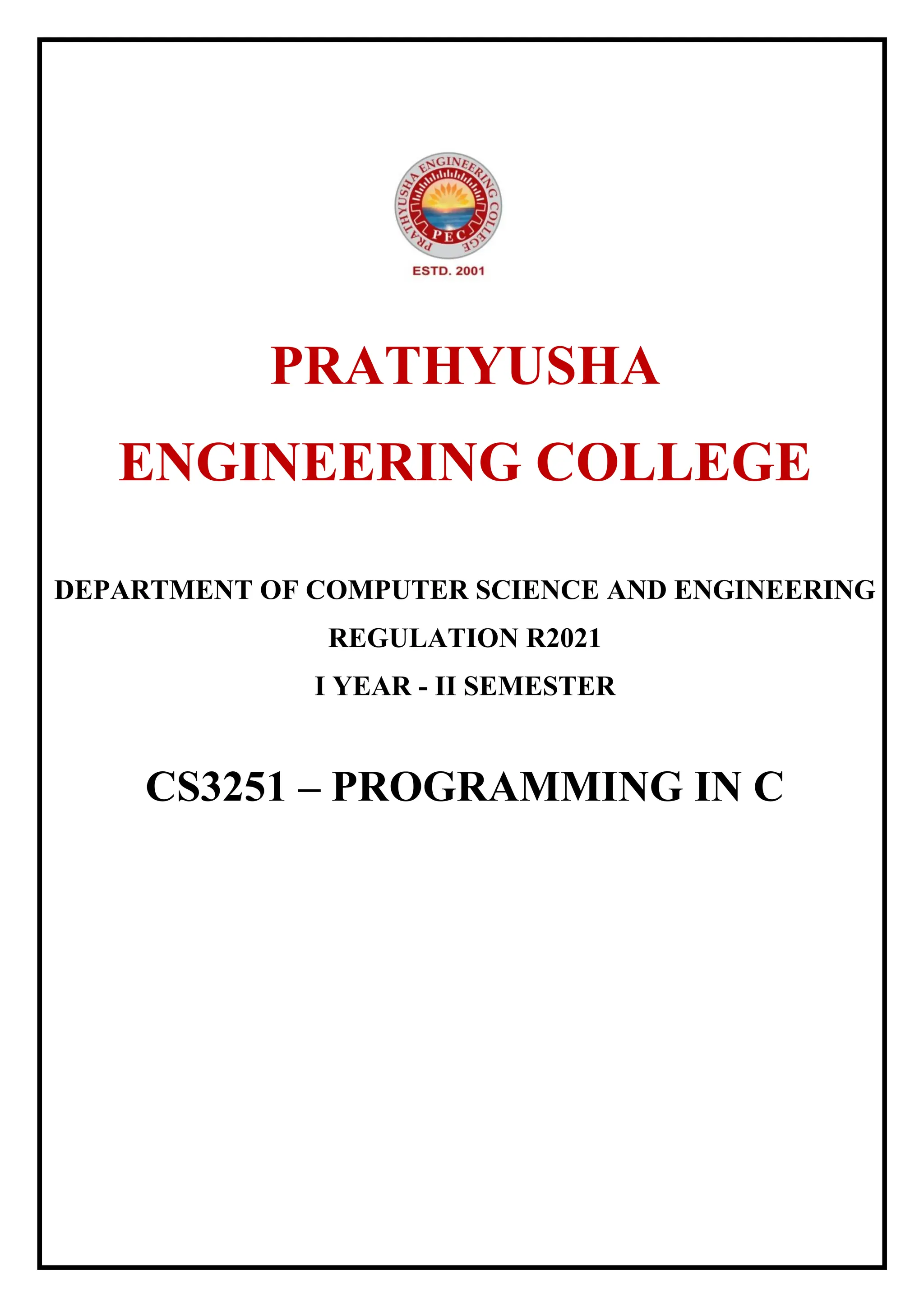

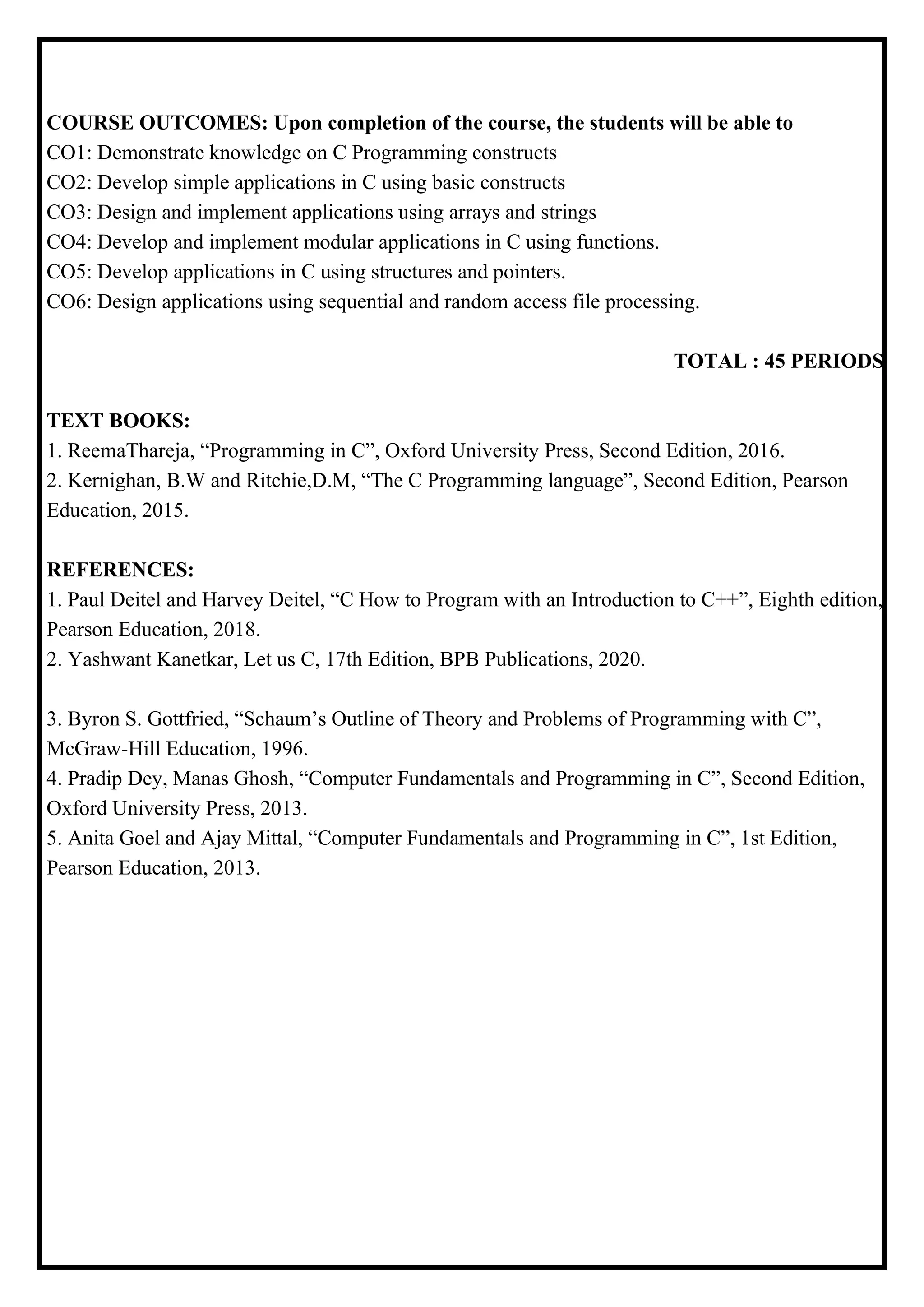

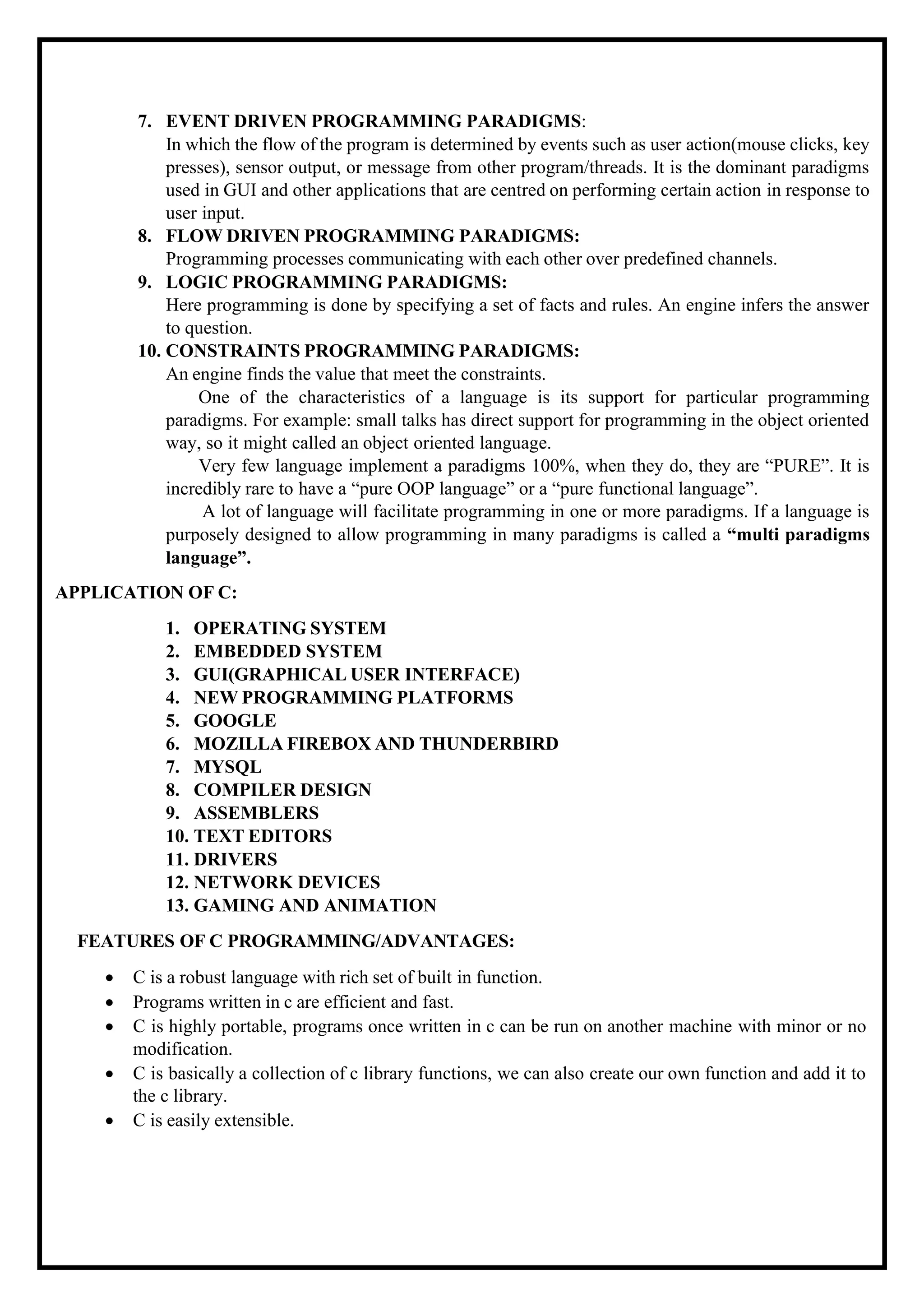
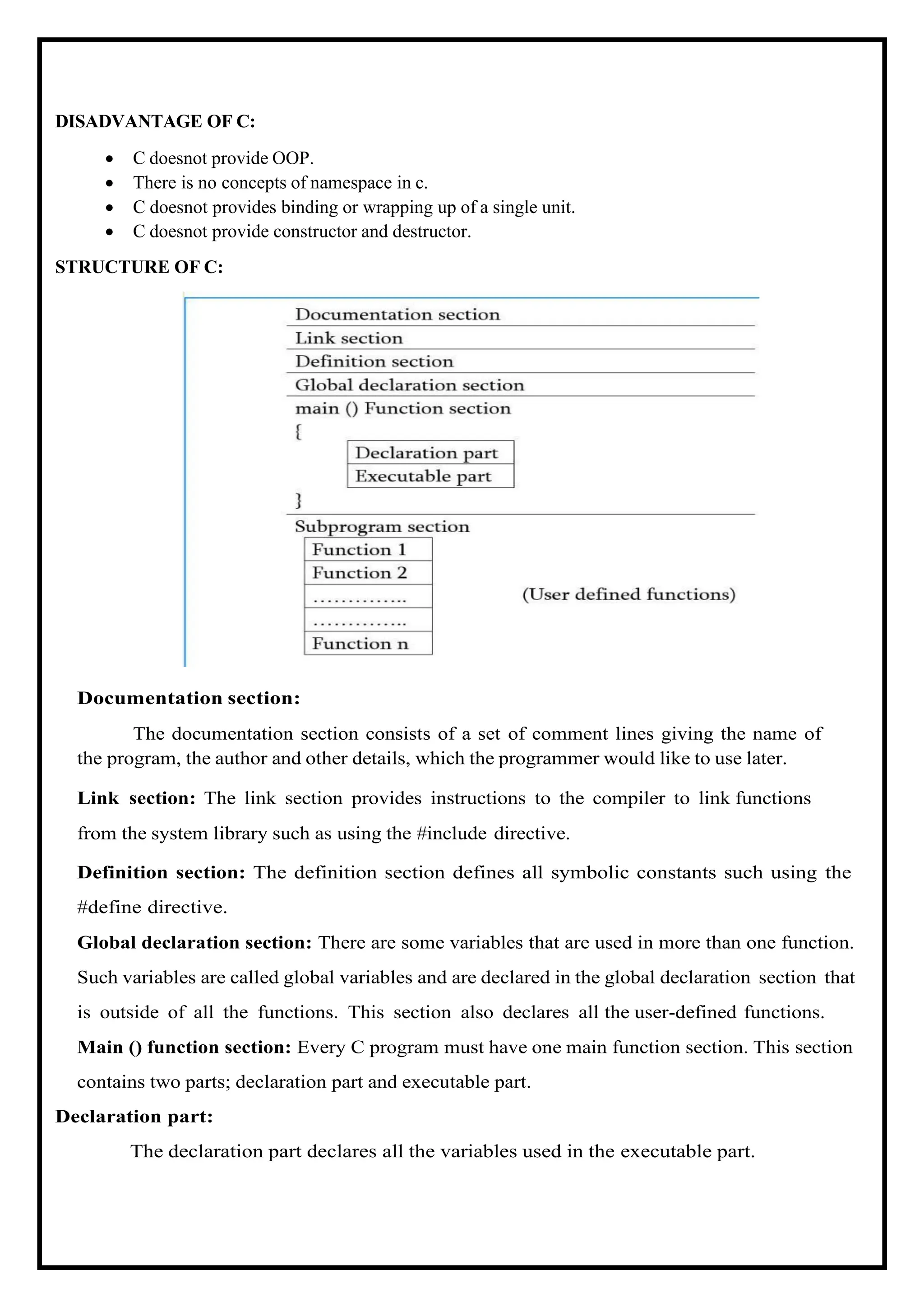

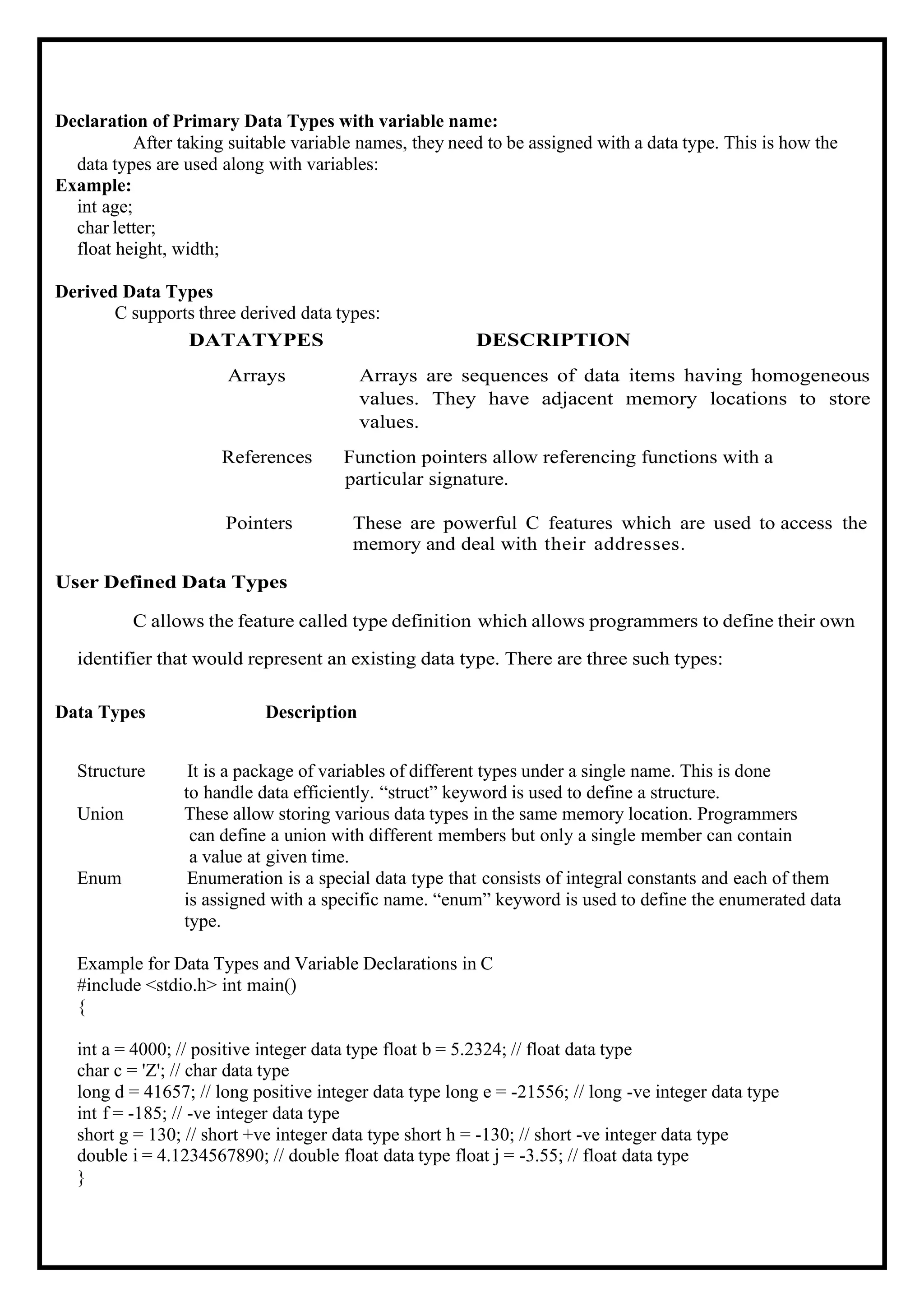

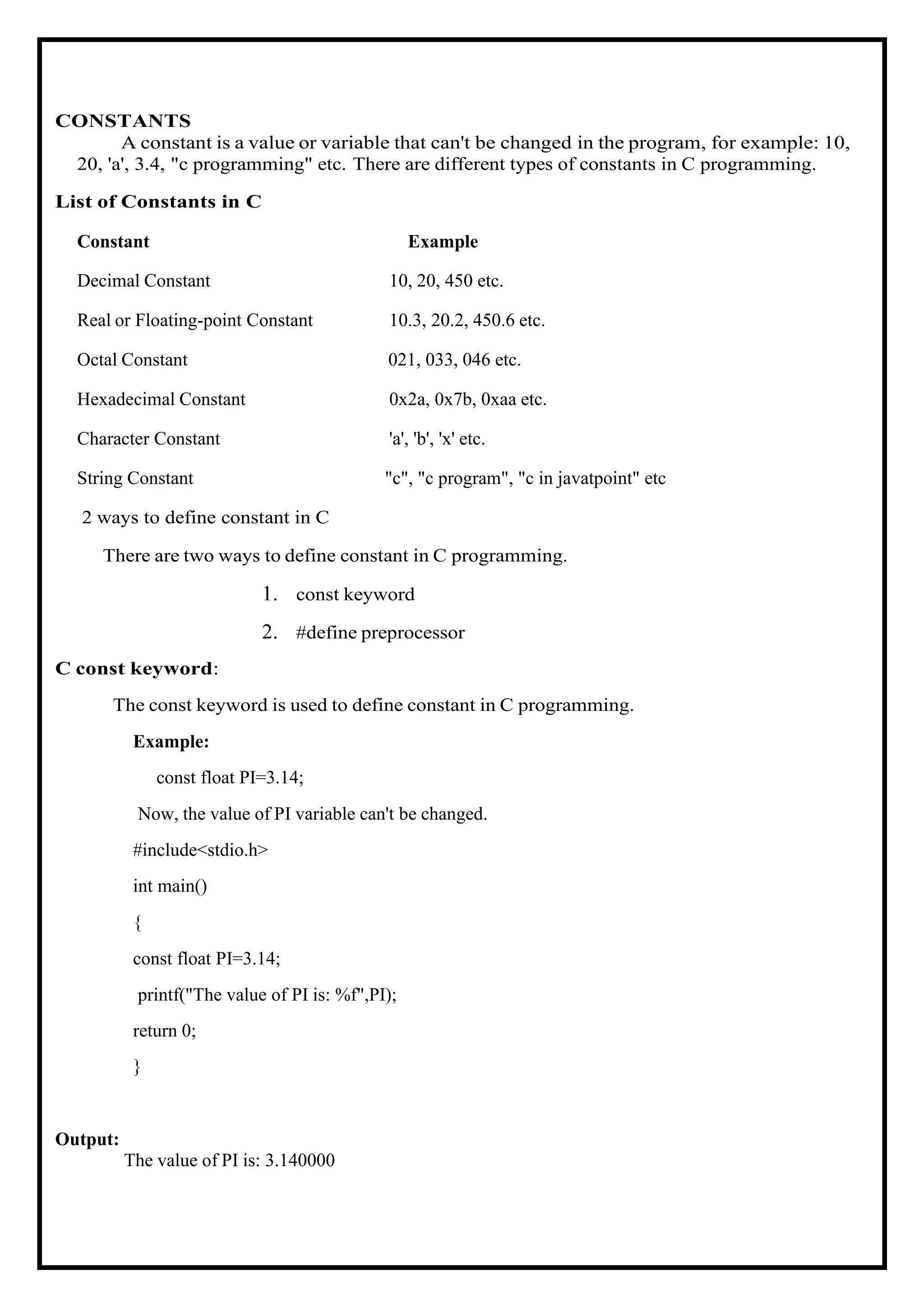
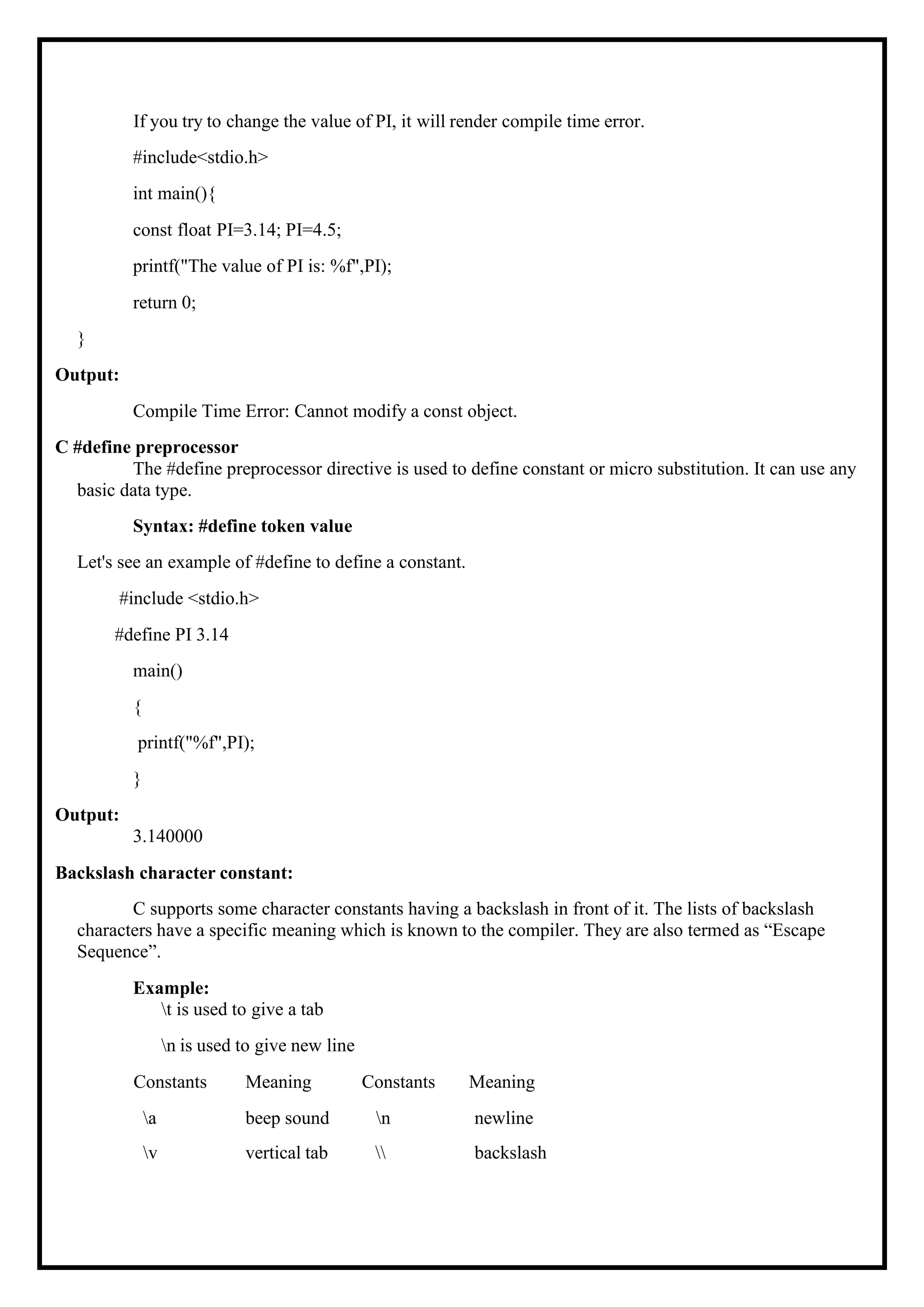

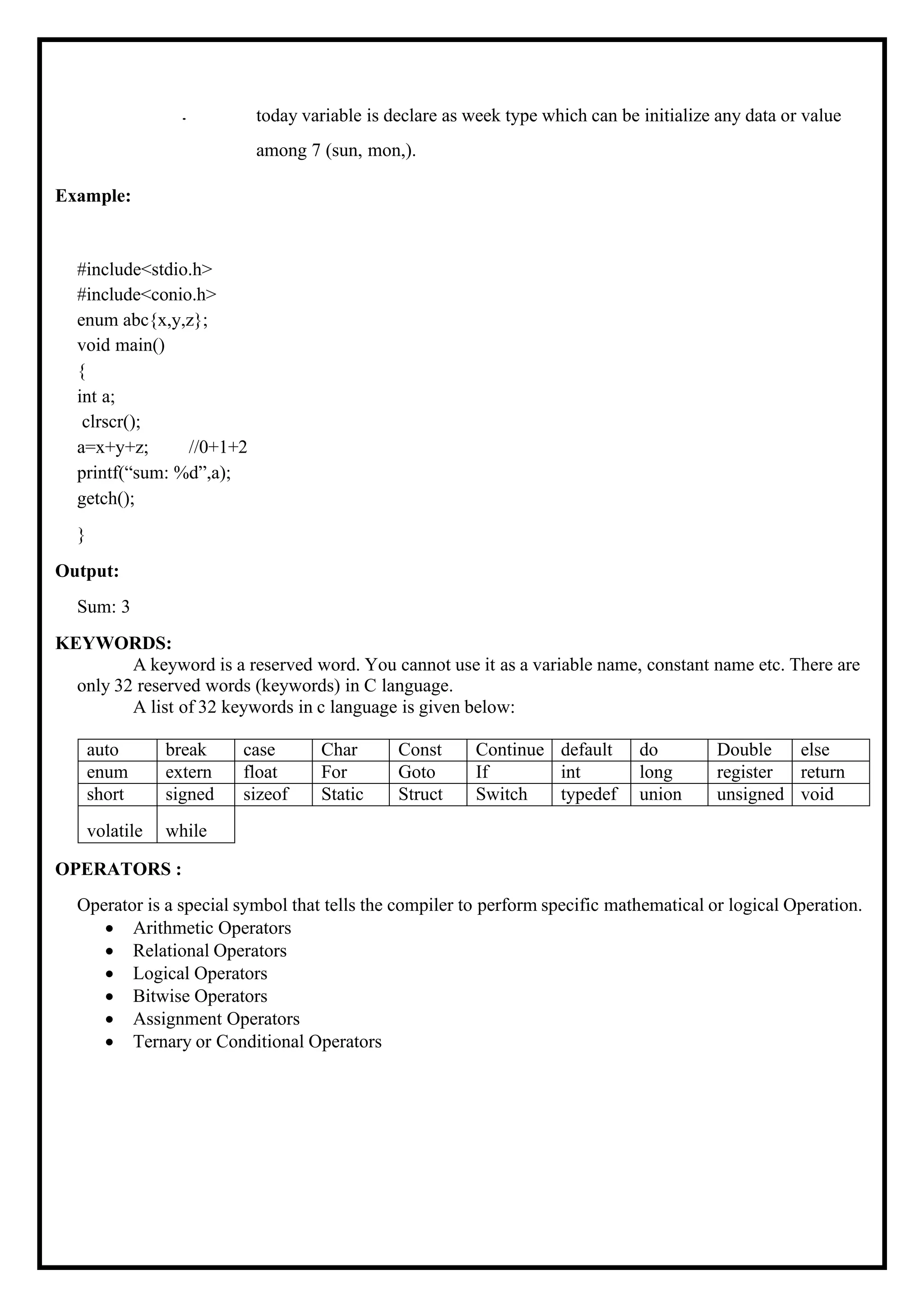
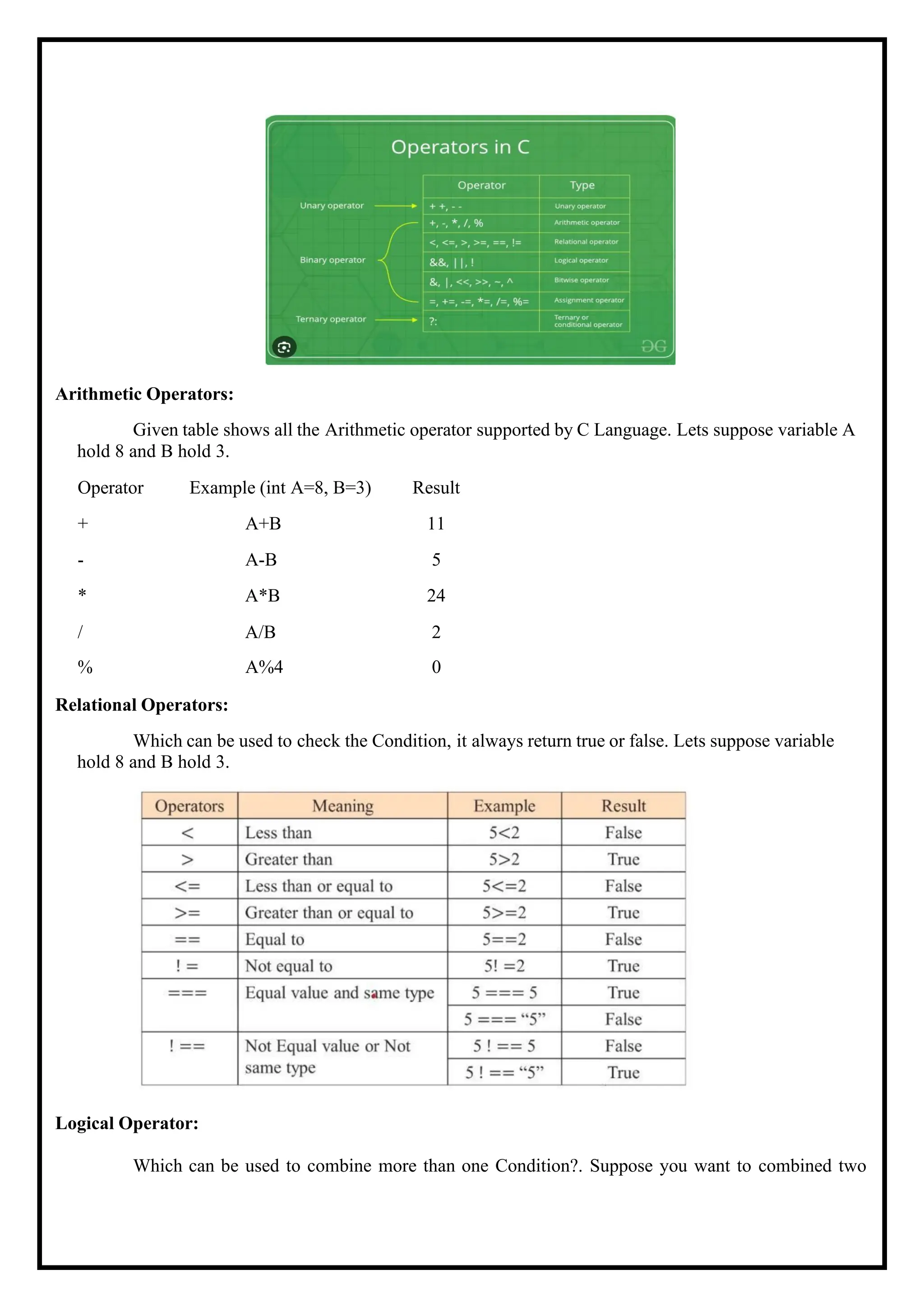
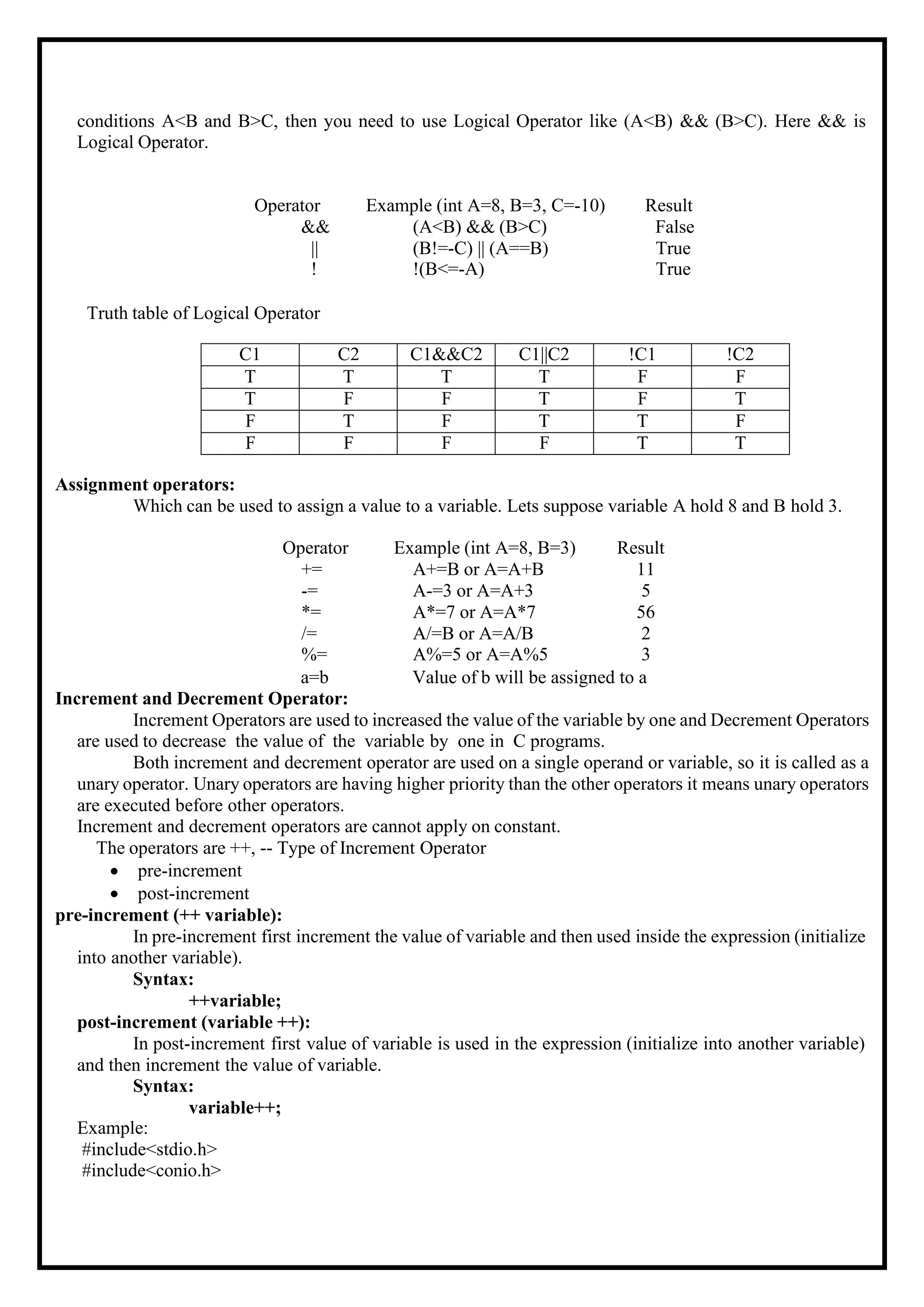

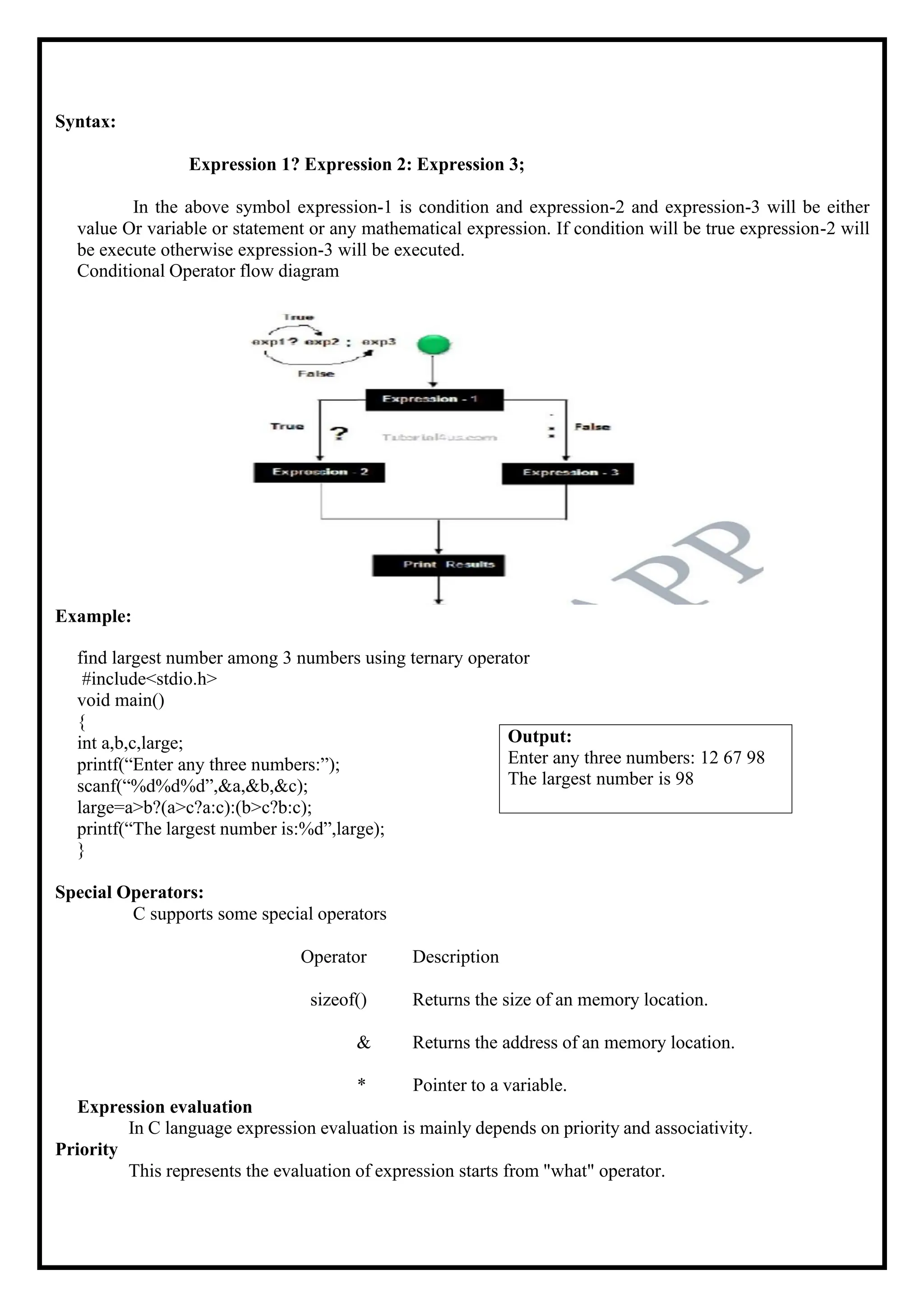
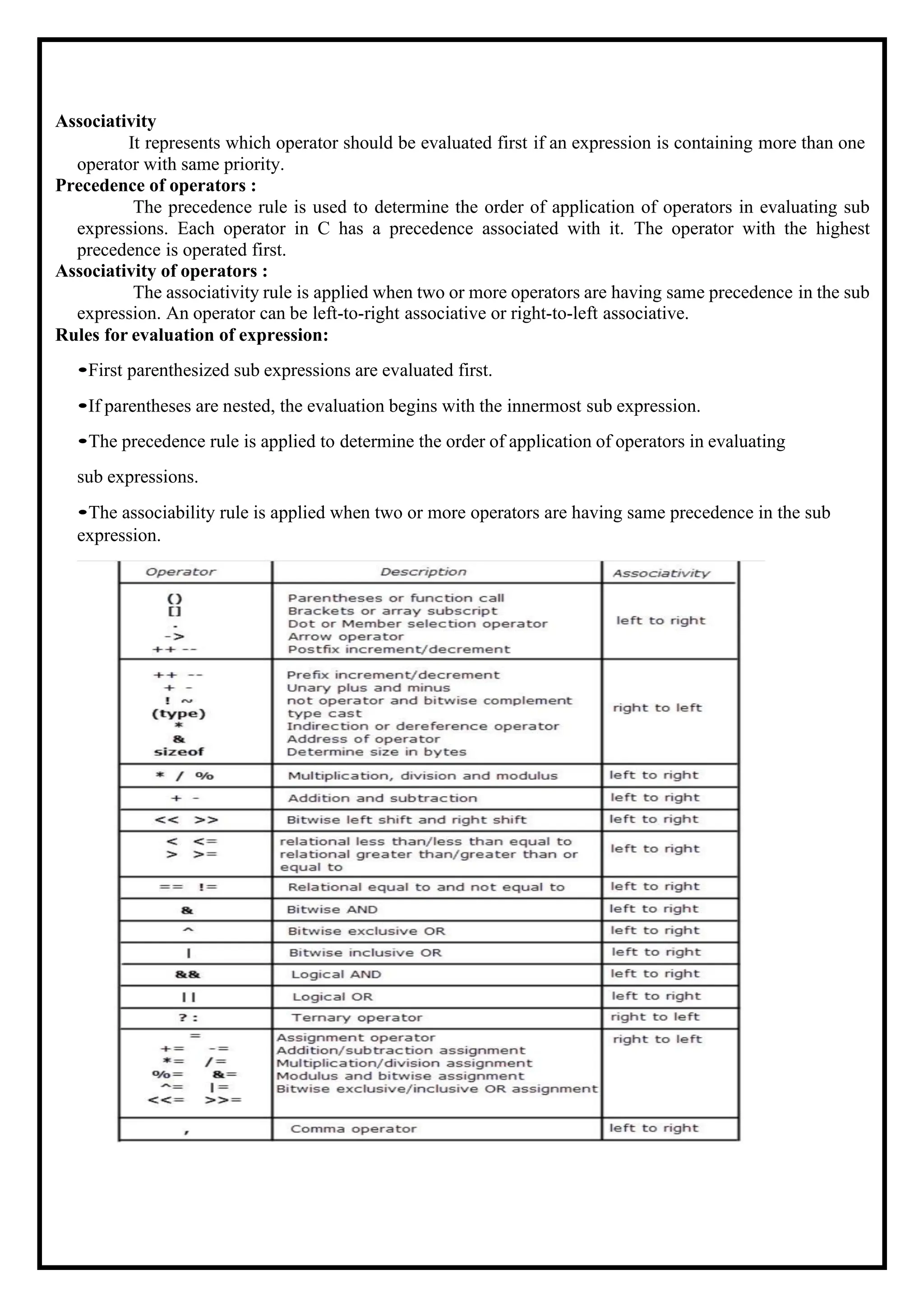
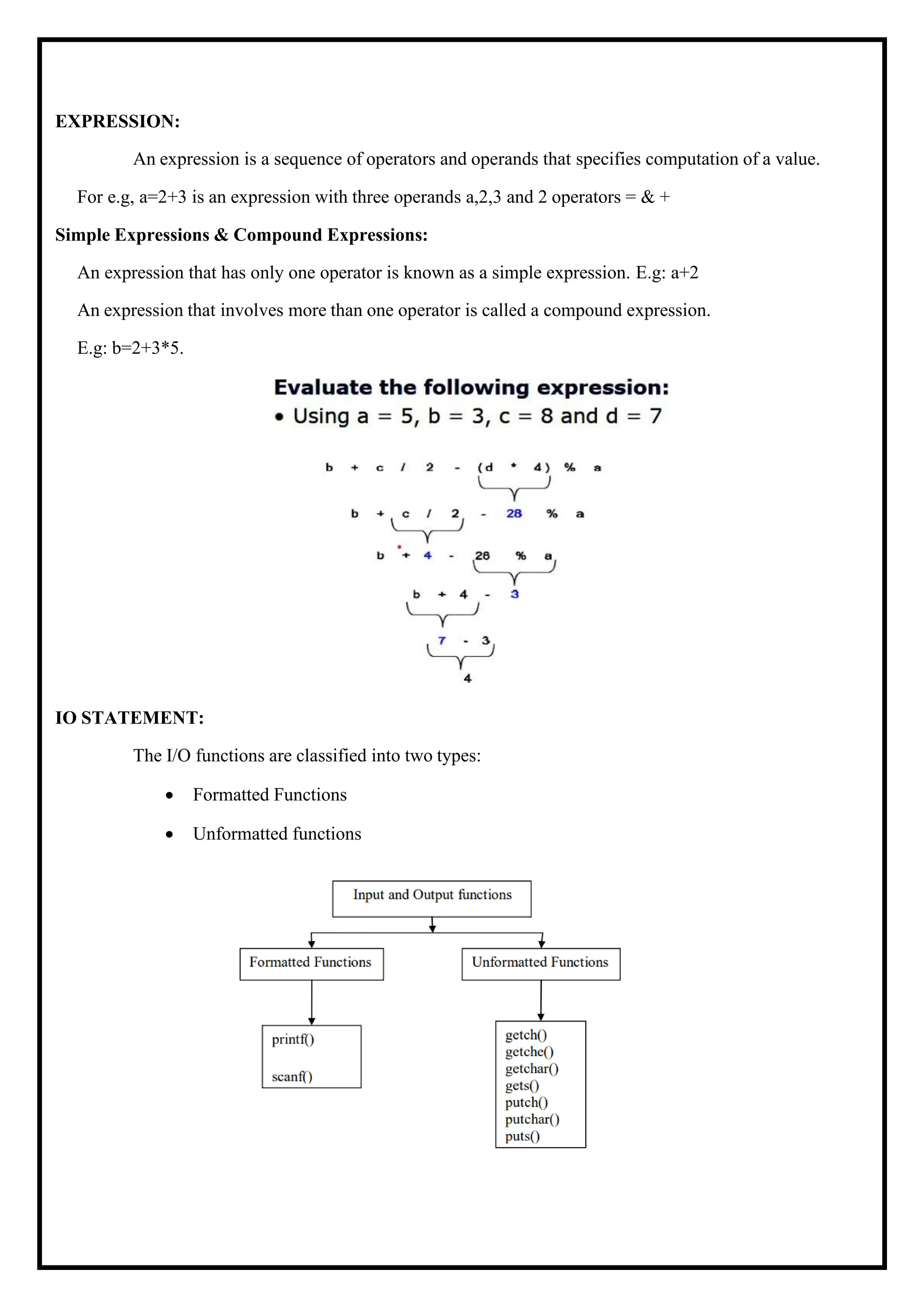
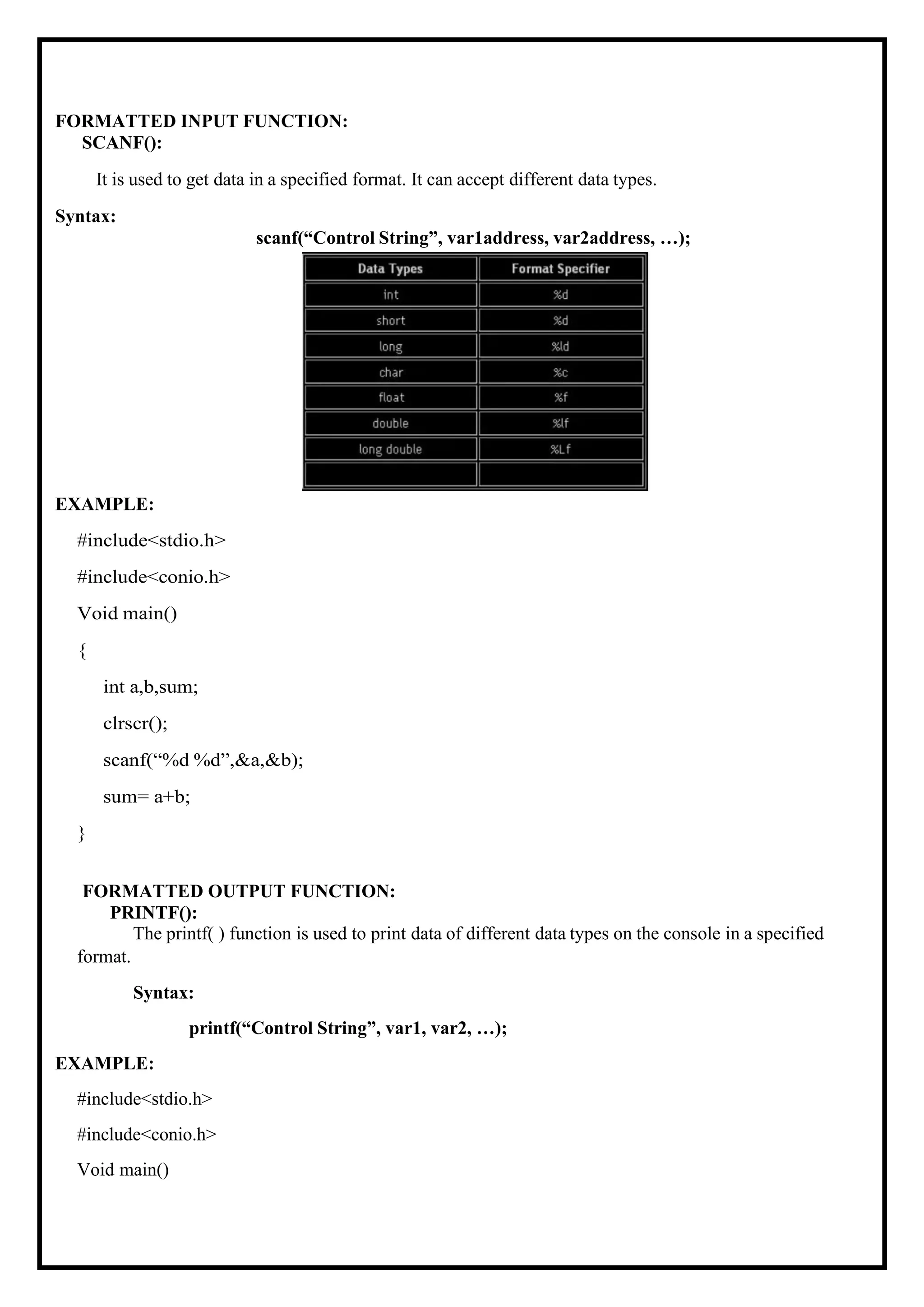
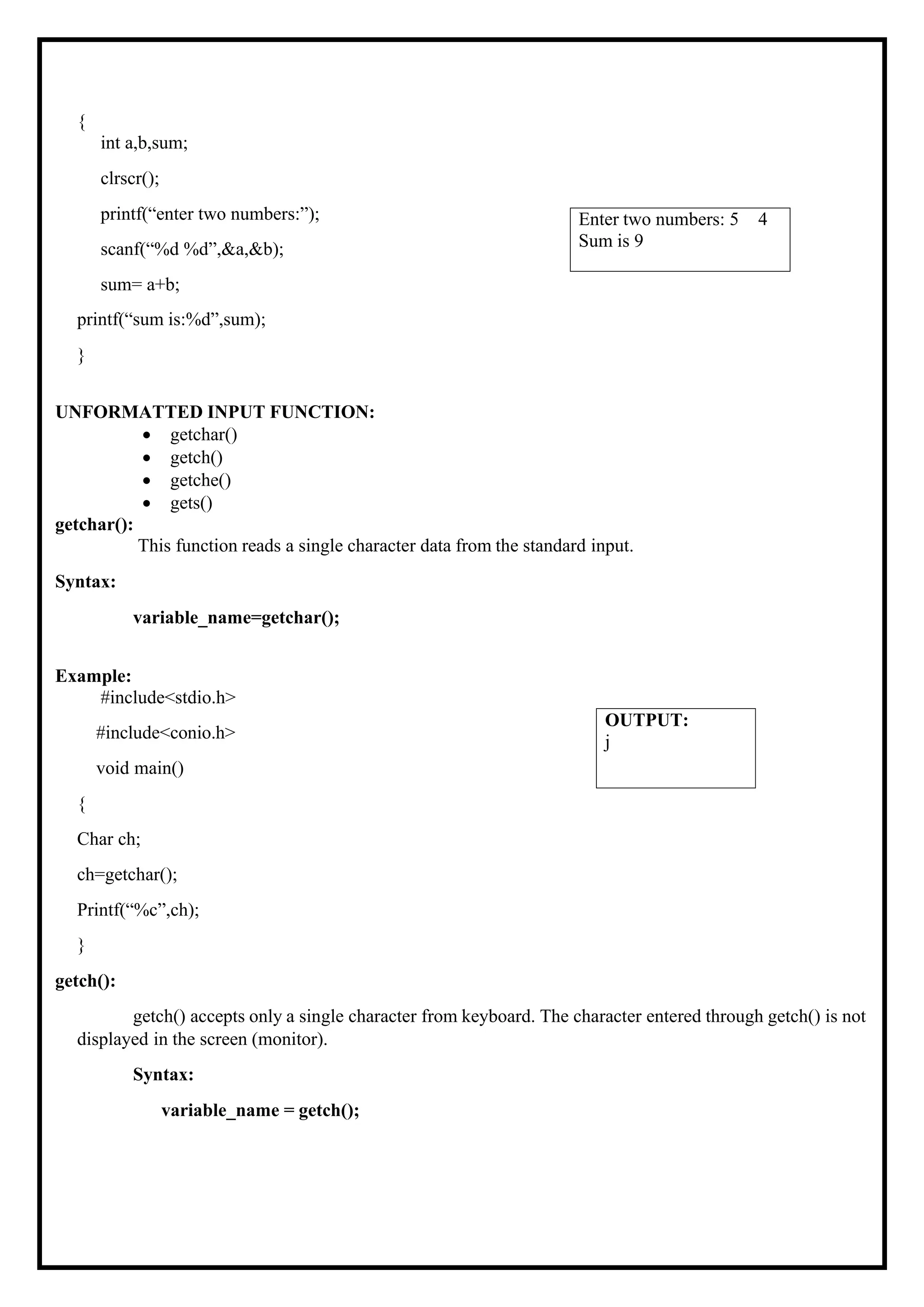

![void main() { Char ch[10]; gets(ch); Printf(“ch=%s”,ch); getch(); } UNFORMATTED OUTPUT FUNCTION: • putchar() • putch() • puts() putchar(): This function prints one character on the screen at a time. Syntax : putchar(variable name); Example: #include<stdio.h> #include<conio.h> void main() { Char ch; printf(“enter a character:”); ch=getchar(); putchar(ch); getch(); } putch(): putch displays any alphanumeric characters to the standard output device. It displays only one character at a time. Syntax: putch(variable_name); OUTPUT: enter a character: j j OUTPUT: cprogram Ch=cprogram](https://image.slidesharecdn.com/c-programming-241018114912-726c2e81/75/C-PROGRAMMING-pdf-text-book-notes-vtu-important-23-2048.jpg)
![Example: include<stdio.h> #include<conio.h> void main() { char ch; clrscr(); printf(“Press any character: ”); ch = getch(); printf(“nPressed character is:”); putch(ch); getch(); } puts(): This function prints the string or character array. Syntax: puts(variable_name); Example: include<stdio.h> #include<conio.h> void main() { char ch[20]; clrscr(); puts(“enter a string”); gets(ch); puts(ch); } OUTPUT: Enter a string: cprogramming cprogramming OUTPUT: Press any character: Pressed character is: e](https://image.slidesharecdn.com/c-programming-241018114912-726c2e81/75/C-PROGRAMMING-pdf-text-book-notes-vtu-important-24-2048.jpg)

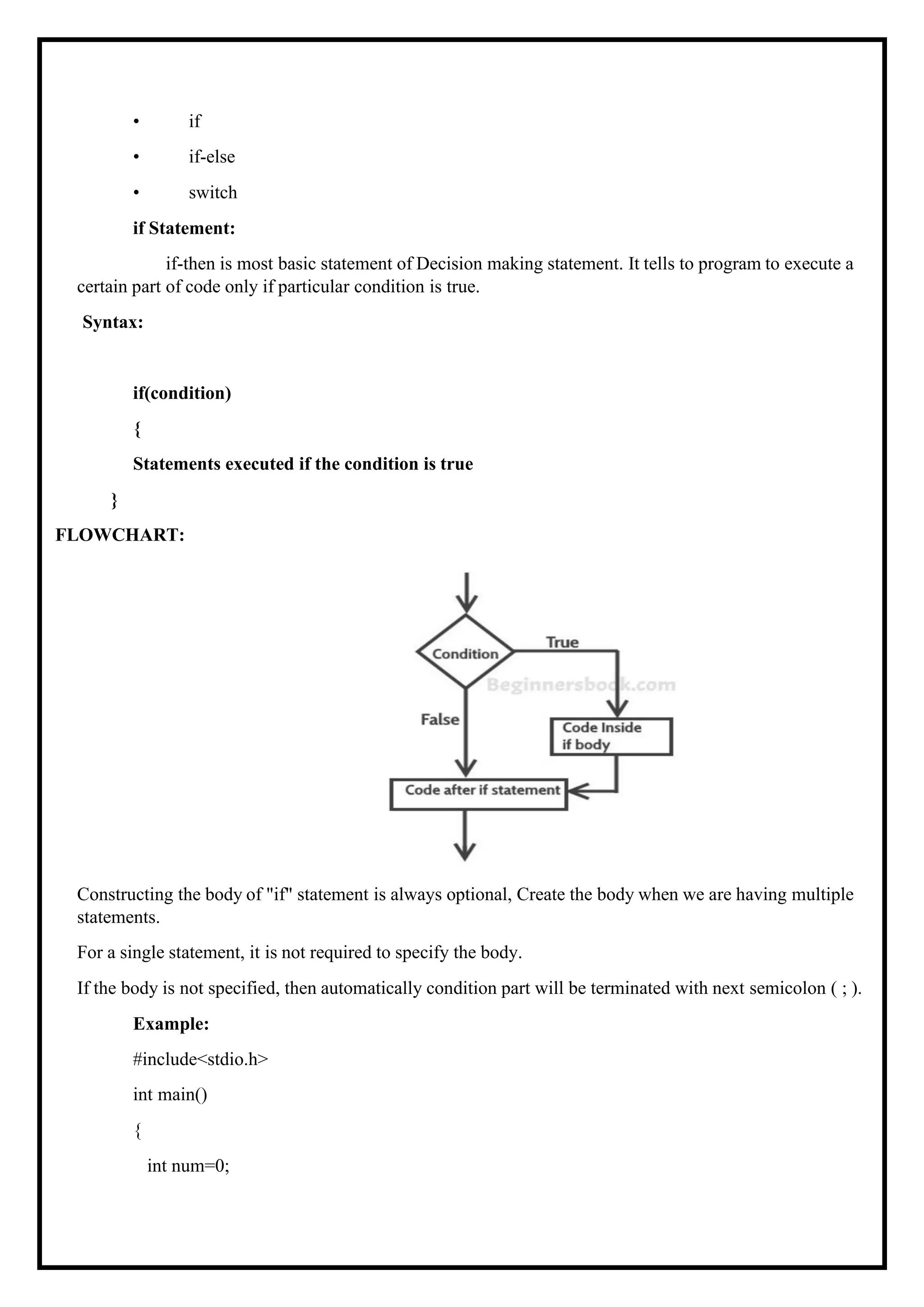

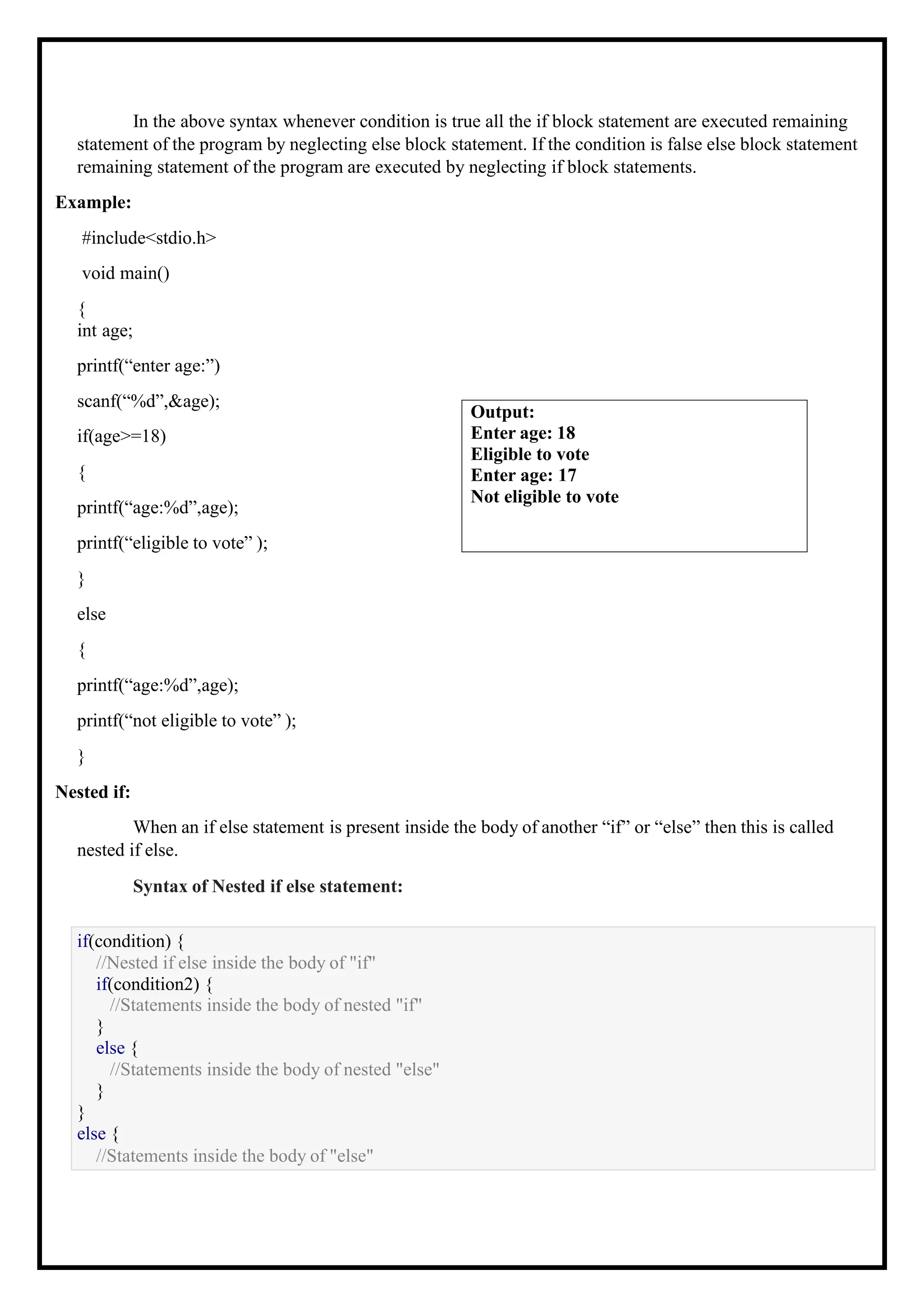
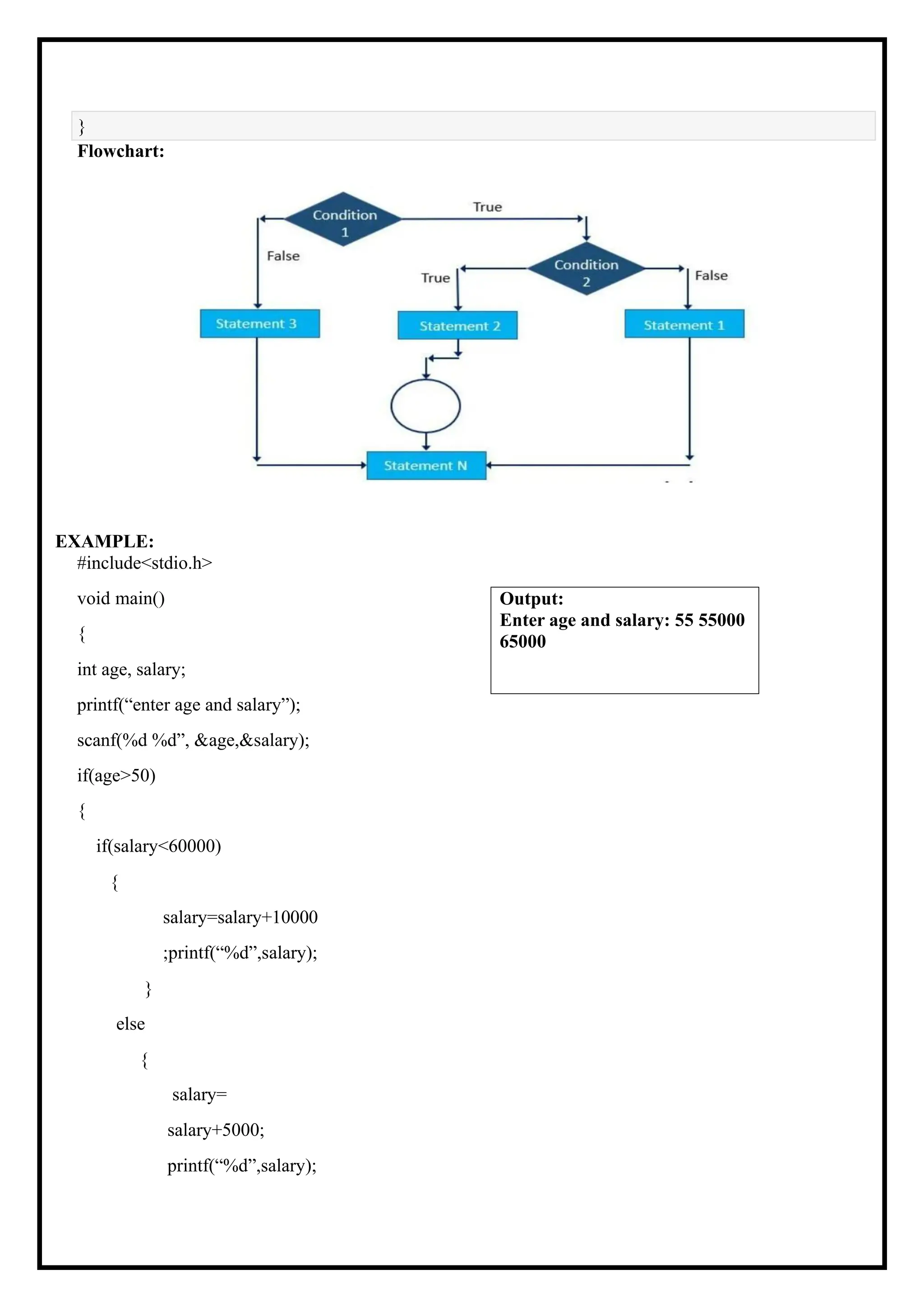
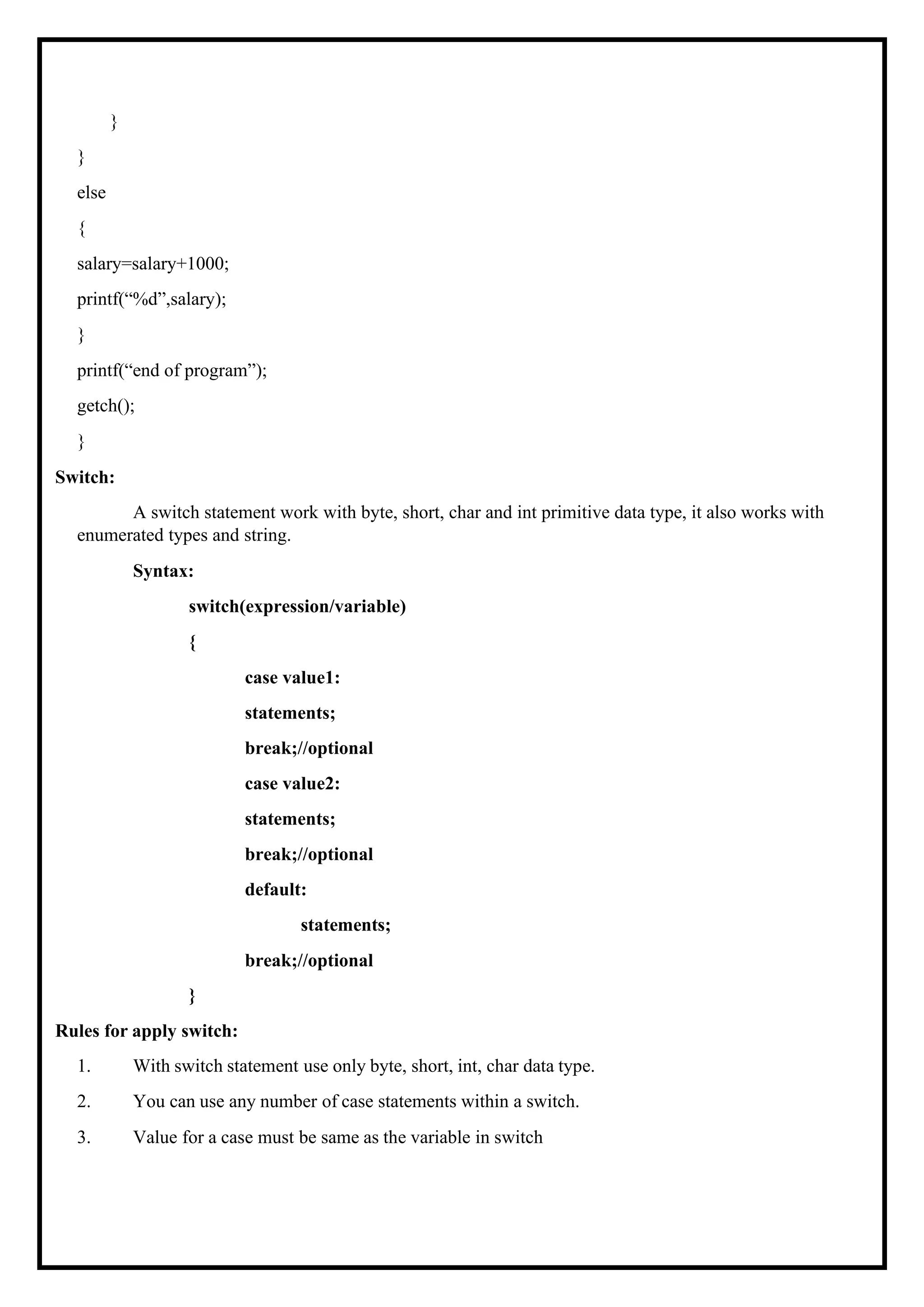

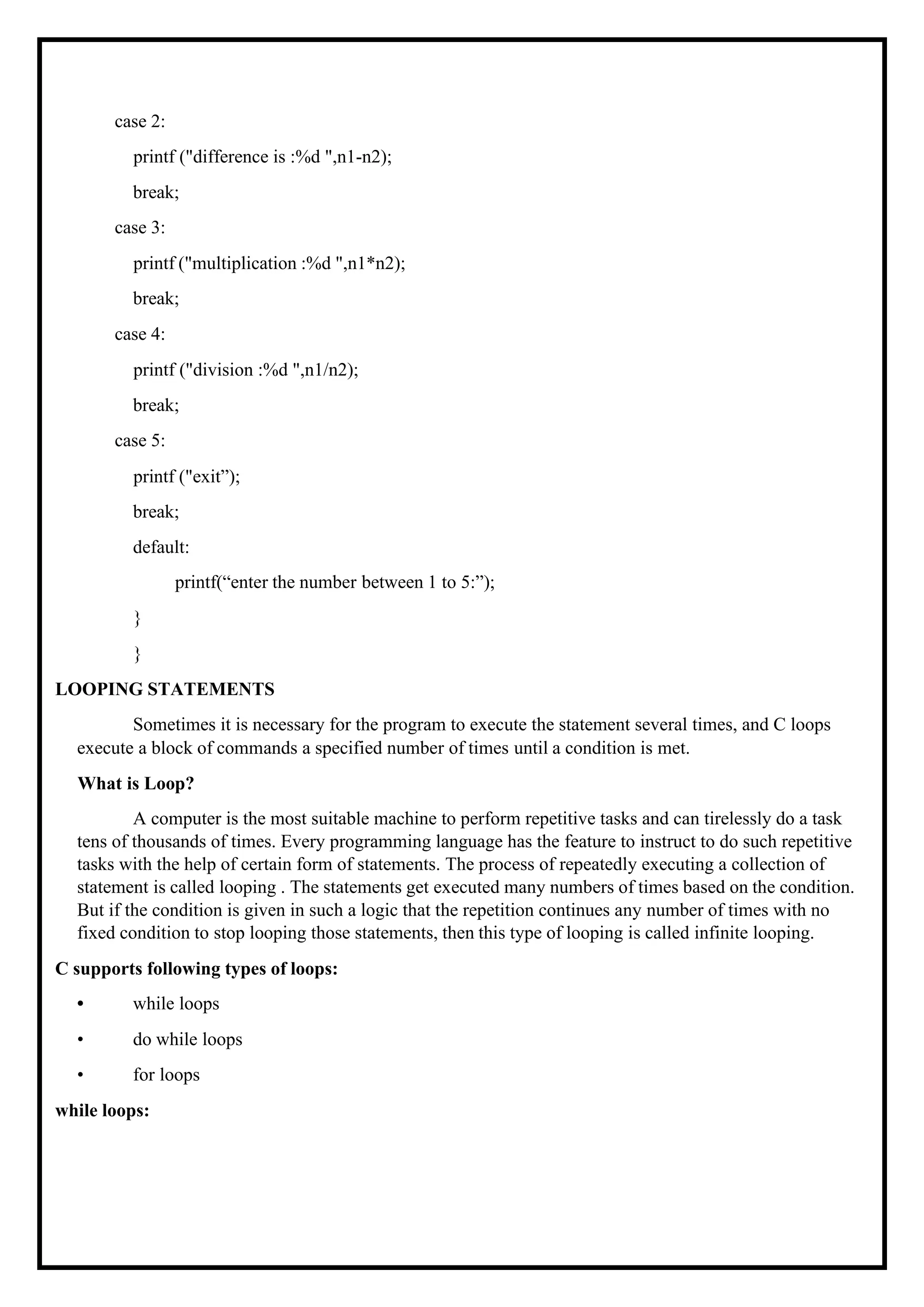

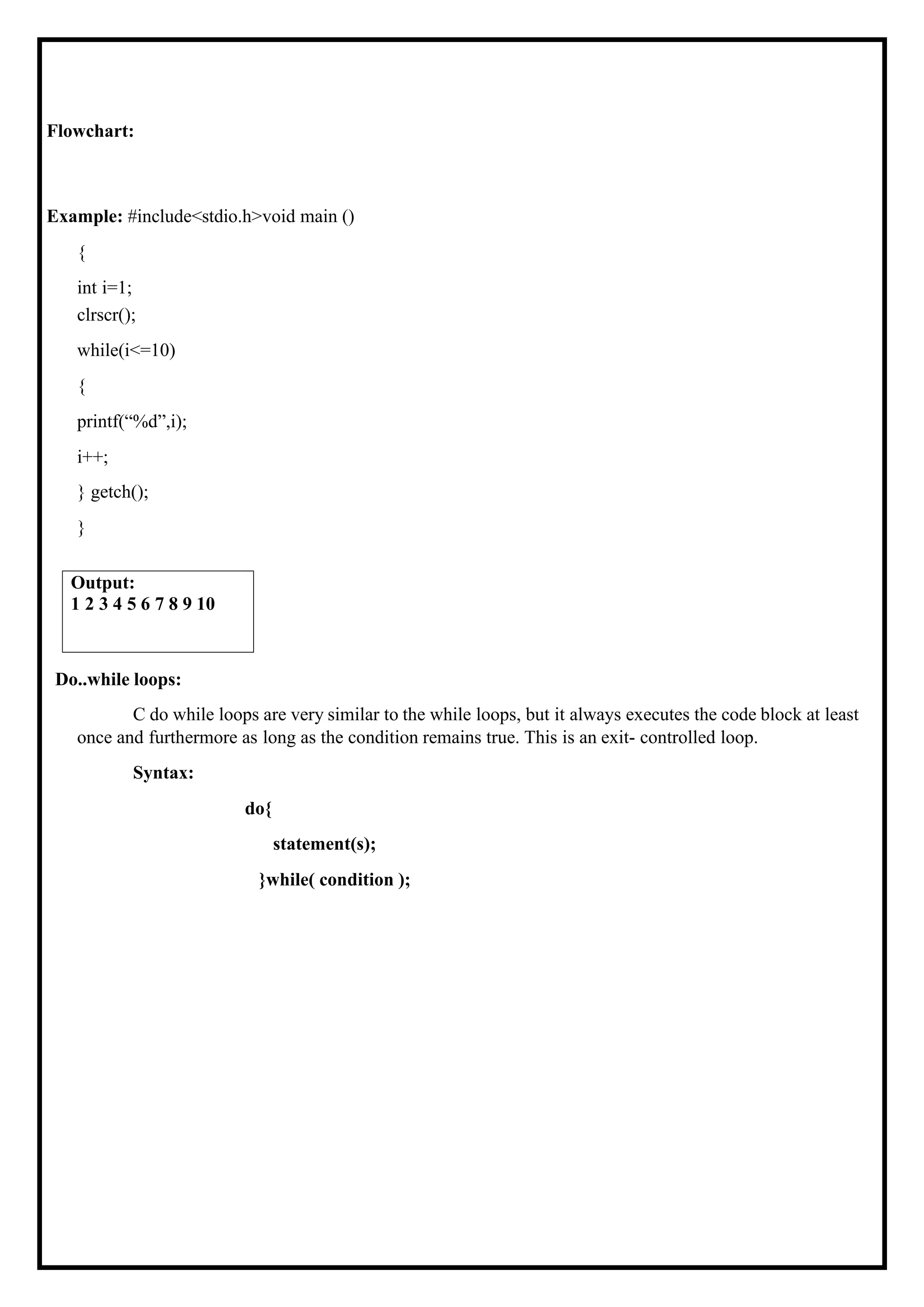
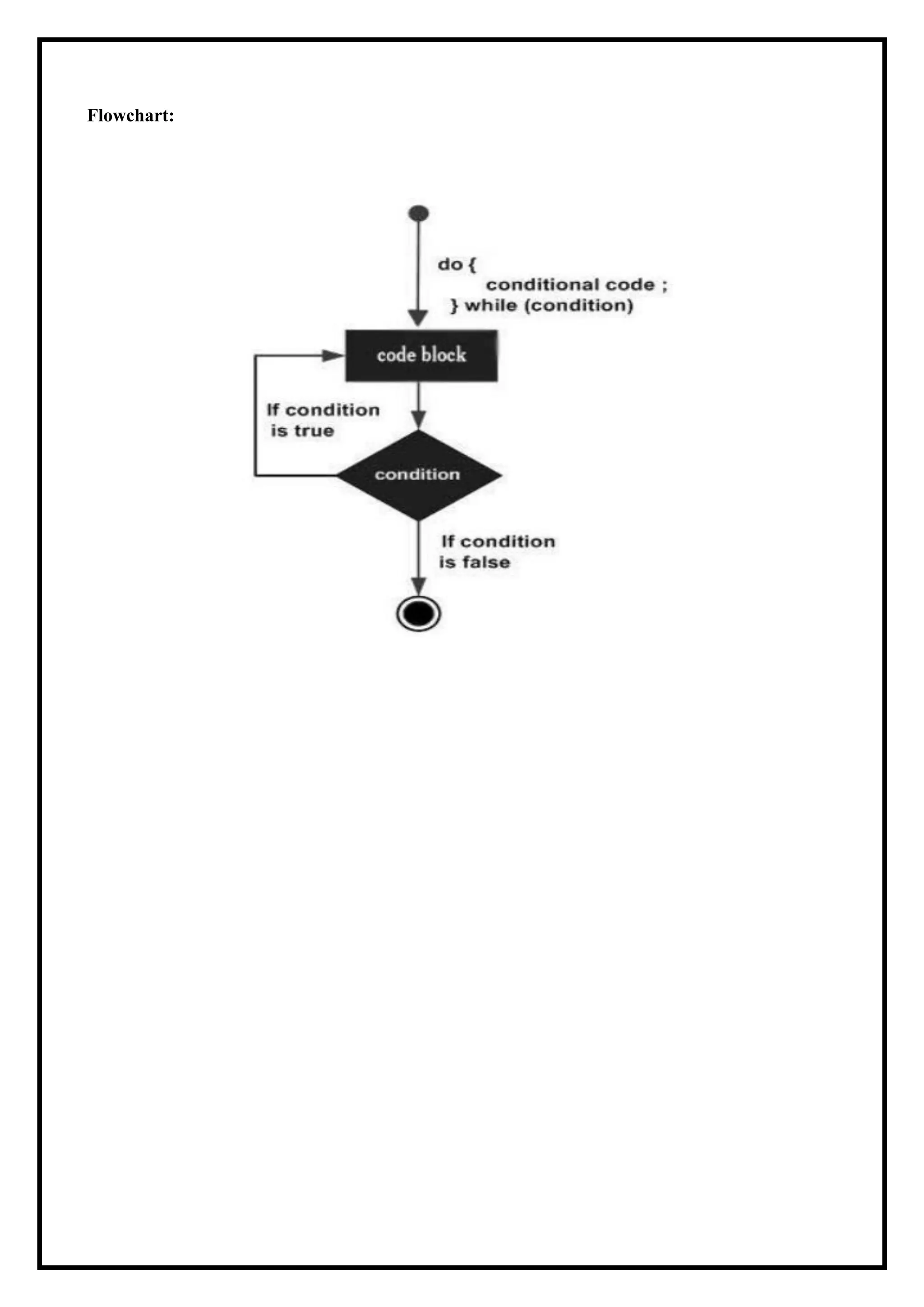


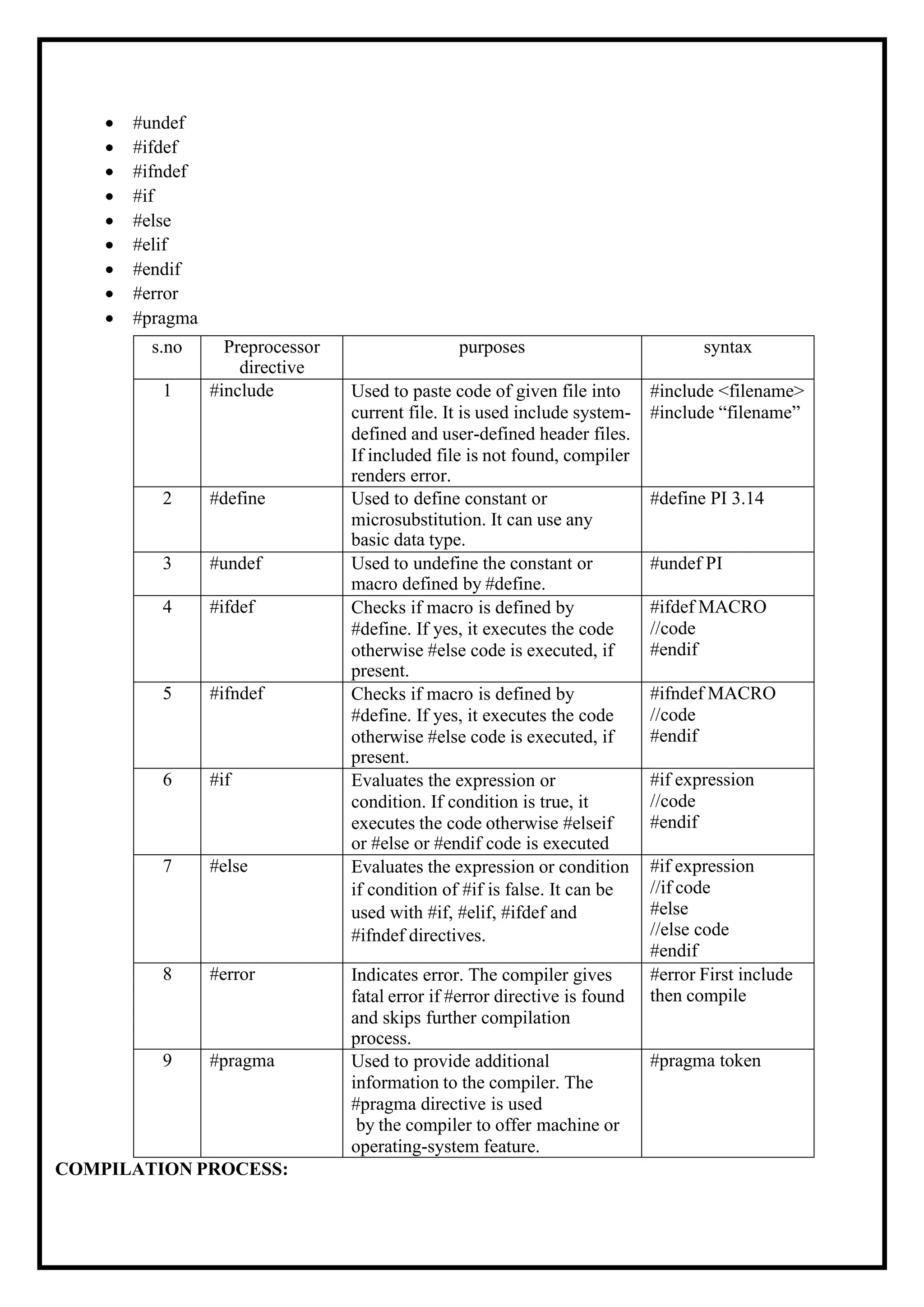
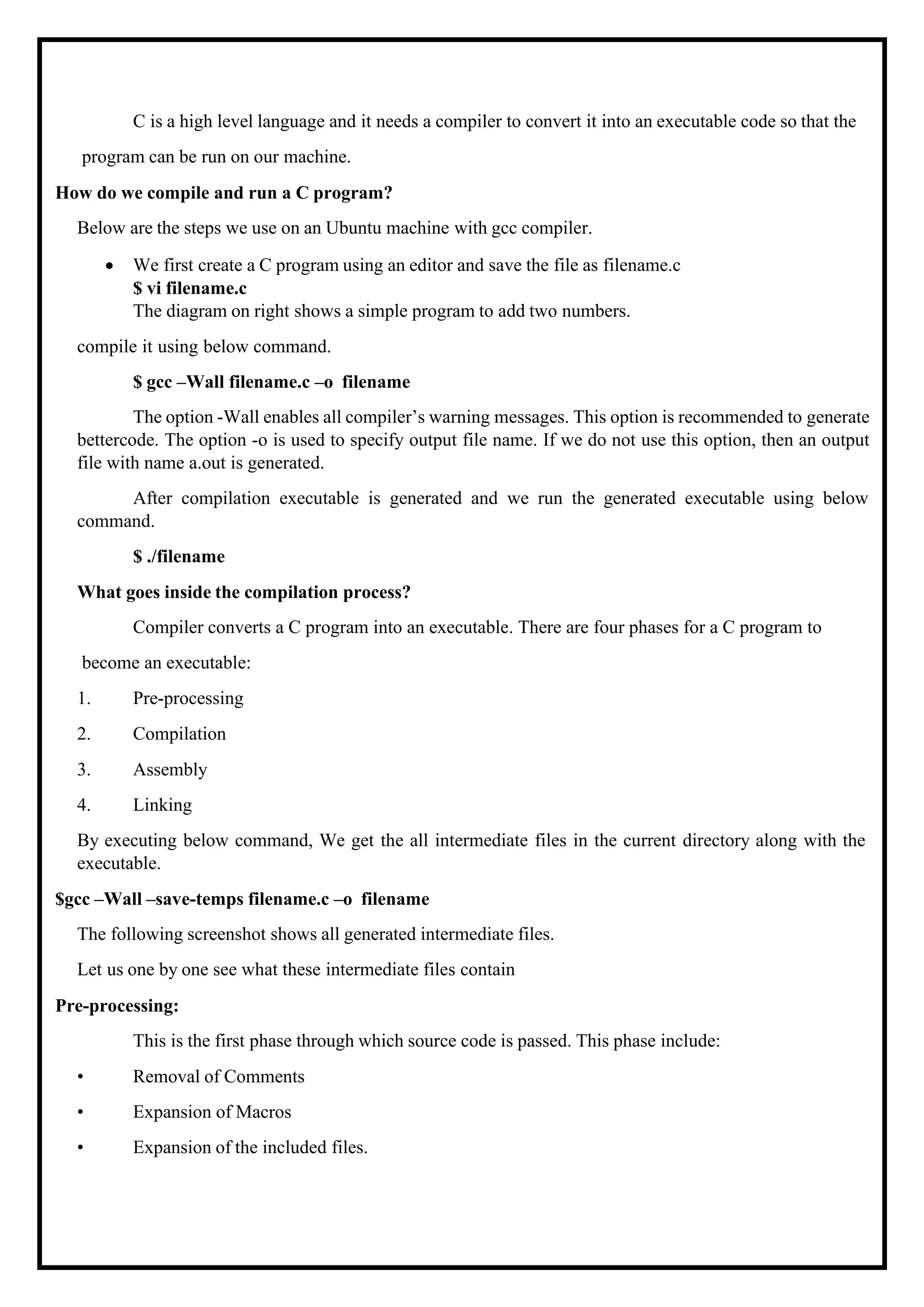

![UNIT II ARRAYS AND STRINGS Introduction to Arrays: Declaration, Initialization – One dimensional array – Two dimensional arrays - String operations: length, compare, concatenate, copy – Selection sort, linear and binary search. INTRODUCTION TO ARRAYS: DECLARATION,INITIALIZATION:ONE DIMENSIONAL ARRAYS: Array in C language is a collection or group of elements (data). All the elements of c array are homogeneous (similar). It has contiguous memory location. C array is beneficial if you have to store similar elements. Suppose you have to store marks of 50 students, one way to do this is allotting 50 variables. So it will be typical and hard to manage. For example we cannot access the value of these variables with only 1 or 2 lines of code. Another way to do this is array. By using array, we can access the elements easily. Only few lines of code is required to access the elements of array. Advantage of C Array: 1) Code Optimization: Less code to the access the data. 2) Easy to traverse data: By using the for loop, we can retrieve the elements of an array easily. 3) Easy to sort data: To sort the elements of array, we need a few lines of code only. 4) Random Access: We can access any element randomly using the array. Disadvantage of C Array: 1) Fixed Size: Whatever size, we define at the time of declaration of array, we can't exceed the limit. So, it doesn't grow the size dynamically like Linked List. Declaration of C Array: We can declare an array in the c language in the following way. Syntax: data_type array_name[array_size]; Now, let us see the example to declare array. int marks[5]; Here, int is the datatype, marks is the array_name and 5 is the array_size. How to access element of an array in C: You can use array subscript (or index) to access any element stored in array. Subscript starts with 0, which means arr[0] represents the first element in the array arr. In general arr[n-1] can be used to access nth element of an array. where n is any integer number. Initialization of C Array: A simple way to initialize array is by index. Notice that array index starts from 0 and ends with [SIZE - 1].](https://image.slidesharecdn.com/c-programming-241018114912-726c2e81/75/C-PROGRAMMING-pdf-text-book-notes-vtu-important-41-2048.jpg)
![marks[0]=80;//initialization of array marks[1]=60; marks[2]=70; marks[3]=85; marks[4]=75; Example: #include<stdio.h> int main() { Output: int i=0; 80 int marks[5];//declaration of array 60 marks[0]=80;//initialization of array 70 marks[1]=60; 85 marks[2]=70; marks[3]=85; 75 marks[4]=75; //traversal of array for(i=0;i<5;i++) { printf("%d n",marks[i]); }//end of for loop return 0; } C Array: Declaration with Initialization: We can initialize the c array at the time of declaration. Let's see the code. int marks[5]={20,30,40,50,60}; In such case, there is no requirement to define size. So it can also be written as the following code . Example: int marks[]={20,30,40,50,60}; Programs: #include<stdio.h> int main() { int i=0; int marks[5]={20,30,40,50,60};//declaration and initialization of array //traversal of array for(i=0;i<5;i++) { printf("%d n",marks[i]); } return 0; } Output: 20 30 40 50 60](https://image.slidesharecdn.com/c-programming-241018114912-726c2e81/75/C-PROGRAMMING-pdf-text-book-notes-vtu-important-42-2048.jpg)
![TWO DIMENSIONAL ARRAYS (2 D arrays): The two dimensional array in C language is represented in the form of rows and columns, also known as matrix. It is also known as array of arrays or list of arrays. The two dimensional, three dimensional or other dimensional arrays are also known as multidimensional arrays. Declaration of two dimensional Array in C: We can declare an array in the c language in the following way. Syntax: data_type array_name[size1][size2]; A simple example to declare two dimensional array is given below. Example: int twodimen[4][3]; Here, 4 is the row number and 3 is the column number. Initialization of 2D Array in C: A way to initialize the two dimensional array at the time of declaration is given below. Programs: Example: int arr[4][3]={{1,2,3},{2,3,4},{3,4,5},{4,5,6}}; #include<stdio.h> int main() { int i=0,j=0; int arr[4][3]={{1,2,3},{2,3,4},{3,4,5},{4,5,6}}; //traversing 2D array for(i=0;i<4;i++) { for(j=0;j<3;j++) { printf("arr[%d] [%d] = %d n",i,j,arr[i][j]); }//end of j }//end of i return 0; } STRING OPERATION: What is meant by String? String in C language is an array of characters that is terminated by 0 (null character). There are two ways to declare string in c language. 1. By char array 2. By string literal Let's see the example of declaring string by char array in C language. char ch[10]={'j', 'a', 'v', 'a', 't', 'p', 'o', 'i', 'n', 't', '0'}; As you know well, array index starts from 0, so it will be represented as in the figure given below. Output: arr[0][0] = 1 arr[0][1] = 2 arr[0][2] = 3 arr[1][0] = 2 arr[1][1] = 3 arr[1][2] = 4 arr[2][0] = 3 arr[2][1] = 4 arr[2][2] = 5 arr[3][0] = 4 arr[3][1] = 5 arr[3][2] = 6](https://image.slidesharecdn.com/c-programming-241018114912-726c2e81/75/C-PROGRAMMING-pdf-text-book-notes-vtu-important-43-2048.jpg)
![Output: Char Array Value is: javatpoint String Literal Value is: javatpoint While declaring string, size is not mandatory. So you can write the above code as given below: char ch[]={'j', 'a', 'v', 'a', 't', 'p', 'o', 'i', 'n', 't', '0'}; You can also define string by string literal in C language. For example: char ch[]="javatpoint"; In such case, '0' will be appended at the end of string by the compiler. Difference between char array and string literal: The only difference is that string literal cannot be changed whereas string declared by char array can be changed. Programs: Let's see a simple example to declare and print string. The '%s' is used to print string in c language. #include<stdio.h> #include <string.h> int main() { char ch[11]={'j', 'a', 'v', 'a', 't', 'p', 'o', 'i', 'n', 't', '0'}; char ch2[11]="javatpoint"; printf("Char Array Value is: %sn", ch); printf("String Literal Value is: %sn", ch2); return 0; } 1. String operations: length-strlen() The strlen() function returns the length of the given string. It doesn't count null character '0'. Example: #include<stdio.h> #include <string.h> int main() { char ch[20]={'j', 'a', 'v', 'a', 't', 'p', 'o', 'i', 'n', 't', '0'}; printf("Length of string is: %d",strlen(ch)); return 0; } 2. String operations: compare-strcmp(): The strcmp(first_string, second_string) function compares two string and returns 0 if both strings are equal. Here, we are using gets() function which reads string from the console. Output: Length of string is: 10](https://image.slidesharecdn.com/c-programming-241018114912-726c2e81/75/C-PROGRAMMING-pdf-text-book-notes-vtu-important-44-2048.jpg)
![Programs: #include<stdio.h> #include <string.h> int main() { char str1[20],str2[20]; printf("Enter 1st string: "); gets(str1);//reads string from console printf("Enter 2nd string: "); gets(str2); if( (strcmp(str1,str2)==0) printf("Strings are equal"); else printf("Strings are not equal"); return 0; } 3. String operations: concatenate-strcat(): The strcat(first_string, second_string) function concatenates two strings and result is returned to first_string. Programs: #include<stdio.h> #include <string.h> int main() { char ch[10]={'h', 'e', 'l', 'l', 'o', '0'}; char ch2[10]={'c', '0'}; strcat(ch,ch2); printf("Value of first string is: %s",ch);return 0; } 4. String operations: copy-strcpy(): The strcpy(destination, source) function copies the source string in destination Programs: #include<stdio.h> #include <string.h> int main() { char ch[20]={'j', 'a', 'v', 'a', 't', 'p', 'o', 'i', 'n', 't', '0'}; char ch2[20]; strcpy(ch2,ch); printf("Value of second string is: %s",ch2); return 0; } 5. String operations:Reverse - strrev(): The strrev(string) function returns reverse of the given string. Let's see a simple example of strrev() function. Output: Value of second string is: javatpoint Output: Value of first string is: helloc Output: Enter 1st string: hello Enter 2nd string: hello Strings are equal](https://image.slidesharecdn.com/c-programming-241018114912-726c2e81/75/C-PROGRAMMING-pdf-text-book-notes-vtu-important-45-2048.jpg)
![Programs: #include<stdio.h> #include <string.h>int main() { char str[20]; printf("Enter string: "); gets(str);//reads string from console printf("String is: %s",str); printf("nReverse String is: %s",strrev(str)); return 0; } 6. String operation: lower- strlwr(): The strlwr(string) function returns string characters in lowercase. Let's see asimple example of strlwr() function. Programs: #include<stdio.h> #include <string.h>int main() { char str[20]; printf("Enter string: "); gets(str);//reads string from console printf("String is: %s",str); printf("nLower String is: %s",strlwr(str)); return 0; } 7. String operation:upper-strupr(): The strupr(string) function returns string characters in uppercase. Let's see a simple example of strupr() function. Programs: #include<stdio.h> #include <string.h> int main() { char str[20]; printf("Enter string: "); gets(str);//reads string from console printf("String is: %s",str); printf("nUpper String is: %s",strupr(str)); return 0; } Output: Enter string: javatpoint String is: javatpoint Upper String is: JAVATPOINT Output: Enter string: JAVATpoint String is: JAVATpoint Lower String is: javatpoint Output: Enter string: javatpoint String is: javatpoint Reverse String is: tnioptavaj](https://image.slidesharecdn.com/c-programming-241018114912-726c2e81/75/C-PROGRAMMING-pdf-text-book-notes-vtu-important-46-2048.jpg)
![Sample Programs: 1. Program to calculate the average marks of the class #include<stdio.h>void main() { int m[5],i,sum=0,n;float avg; printf(“enter number of students n”); scanf(“%d”,&n); printf(“enter marks of students n”); for(i=0;i <n;i++) sum=sum+m[i]; avg=float(sum)/n; printf(“average of:%f”,avg); } 2. Addition of two numbers in array: #include <stdio.h> void main() { int a[10], b[10], c[10], n, i; printf("Enter the number of elements:t"); scanf("%d", &n); printf("Enter %d elements for array 1:n", n); for (i = 0; i < n; i++) scanf("%d", &a[i]); printf("Enter %d elements for array 2:n", n); for (i = 0; i < n; i++) scanf("%d", &b[i]); for (i = 0; i < n; i++) c[i] = a[i] + b[i]; printf("Sum of two array elements are:n"); for (i = 0; i < n; i++) printf("%dn", c[i]); } Output: Enter the number of elements: 5Enter 5 elements for array 1: 93 37 71 03 17 Enter 5 elements for array 2: 29 84 28 75 63 Sum of two array elements are:122 Output: Enter number of students 5 Enter marks of students 55 60 78 85 90 Average of: 73.6](https://image.slidesharecdn.com/c-programming-241018114912-726c2e81/75/C-PROGRAMMING-pdf-text-book-notes-vtu-important-47-2048.jpg)
![121 99 78 80 3. Subtraction of two number: #include < stdio.h > int main() { int m, n, c, d, first[10][10], second[10][10], difference[10][10]; printf("Enter the number of rows and columns of matrixn"); scanf("%d%d", & m, & n); printf("Enter the elements of first matrixn"); for (c = 0; c < m; c++) for (d = 0; d < n; d++) scanf("%d", & first[c][d]); printf("Enter the elements of second matrixn"); for (c = 0; c < m; c++) for (d = 0; d < n; d++) scanf("%d", & second[c][d]); printf("Difference of entered matrices:-n"); for (c = 0; c < m; c++) { for (d = 0; d < n; d++) { difference[c][d] = first[c][d] - second[c][d]; printf("%dt", difference[c][d]); } printf("n"); } return 0; }](https://image.slidesharecdn.com/c-programming-241018114912-726c2e81/75/C-PROGRAMMING-pdf-text-book-notes-vtu-important-48-2048.jpg)
![4. Multiplication of two numbers in array: #include<stdio.h> #include<stdlib.h> int main(){ int a[10][10],b[10][10],mul[10][10],r,c,i,j,k; system("cls"); printf("enter the number of row="); scanf("%d",&r); printf("enter the number of column="); scanf("%d",&c); printf("enter the first matrix element=n"); for(i=0;i<r;i++) { for(j=0;j<c;j++) { scanf("%d",&a[i][j]); } } printf("enter the second matrix element=n"); for(i=0;i<r;i++) { for(j=0;j<c;j++) { scanf("%d",&b[i][j]); } } printf("multiply of the matrix=n"); for(i=0;i<r;i++) { for(j=0;j<c;j++) { mul[i][j]=0; for(k=0;k<c;k++) { mul[i][j]+=a[i][k]*b[k][j]; } } } //for printing result for(i=0;i<r;i++) {](https://image.slidesharecdn.com/c-programming-241018114912-726c2e81/75/C-PROGRAMMING-pdf-text-book-notes-vtu-important-49-2048.jpg)
![for(j=0;j<c;j++) { printf("%dt",mul[i][j]); } printf("n"); } return 0; } Output: enter the number of row=3 enter the number of column=3 enter the first matrix element= 1 1 1 2 2 2 3 3 3 enter the second matrix element= 1 1 1 2 2 2 3 3 3 multiply of the matrix= 6 6 6 12 12 12 18 18 18](https://image.slidesharecdn.com/c-programming-241018114912-726c2e81/75/C-PROGRAMMING-pdf-text-book-notes-vtu-important-50-2048.jpg)



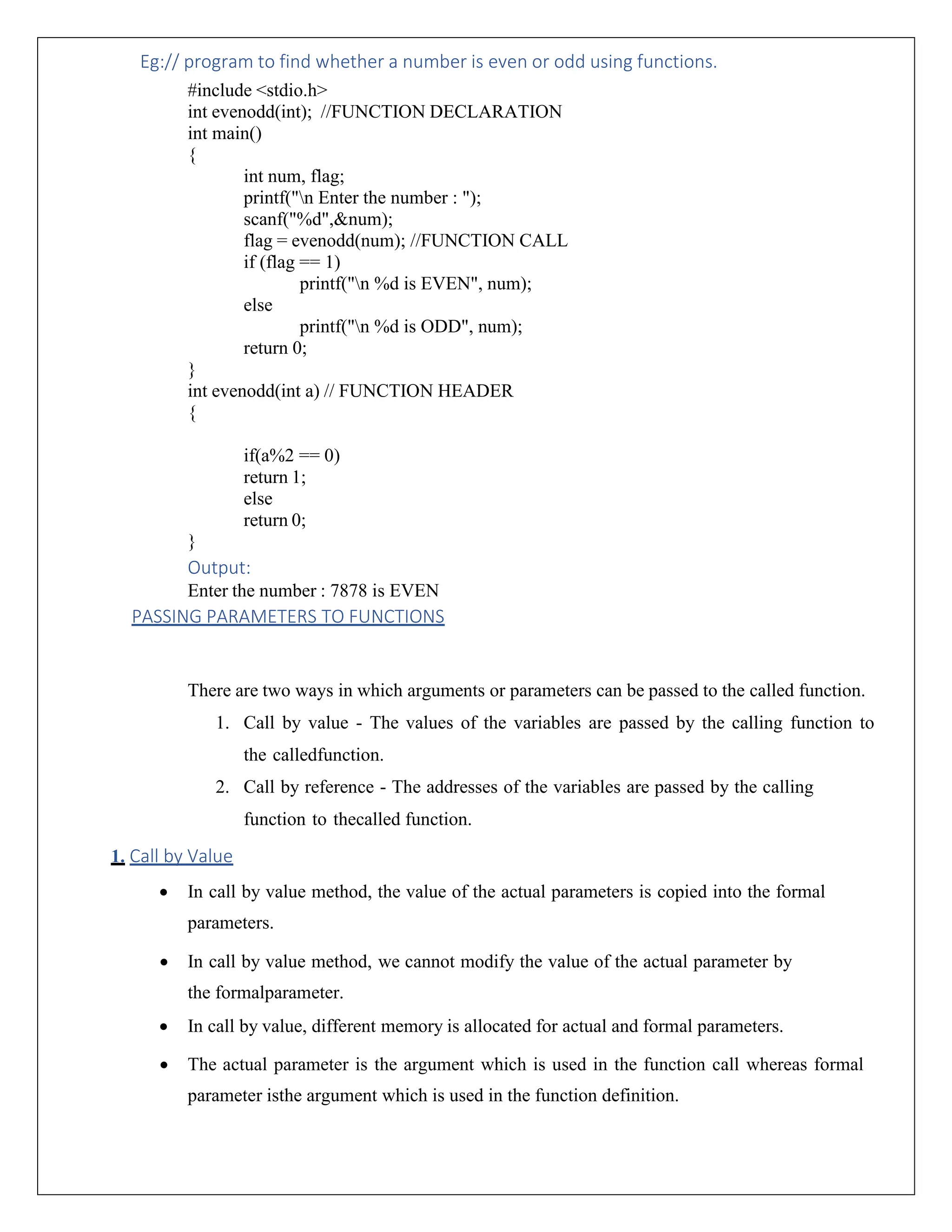
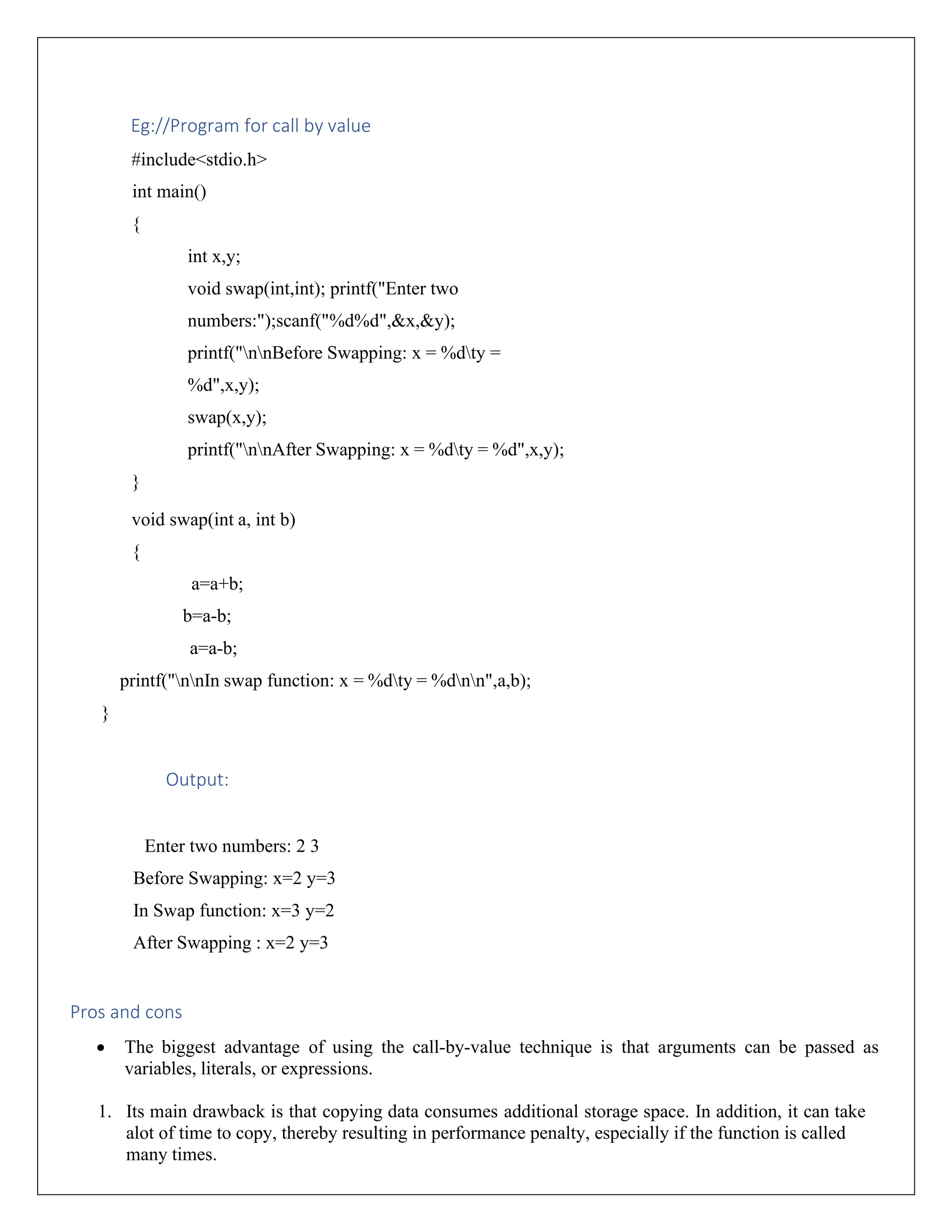
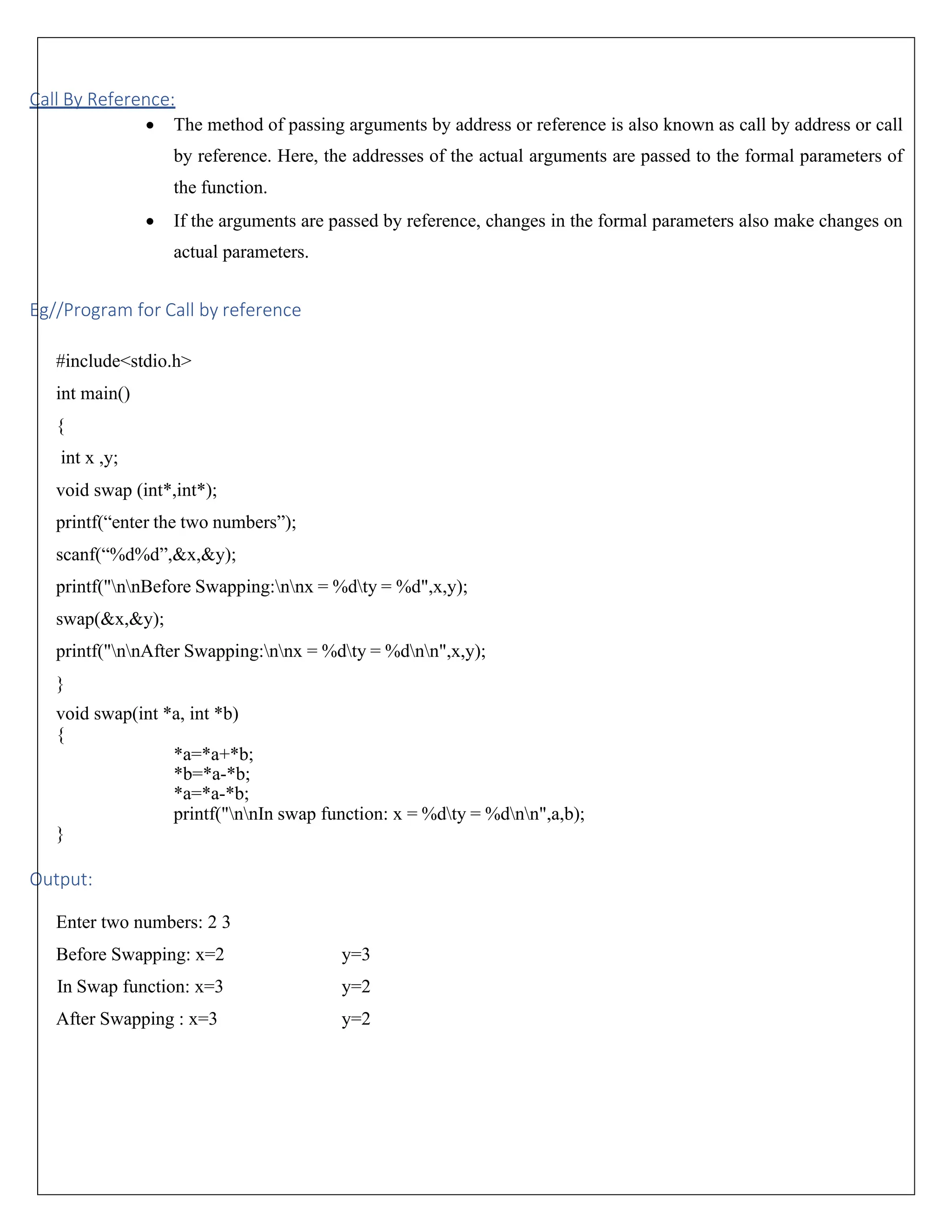
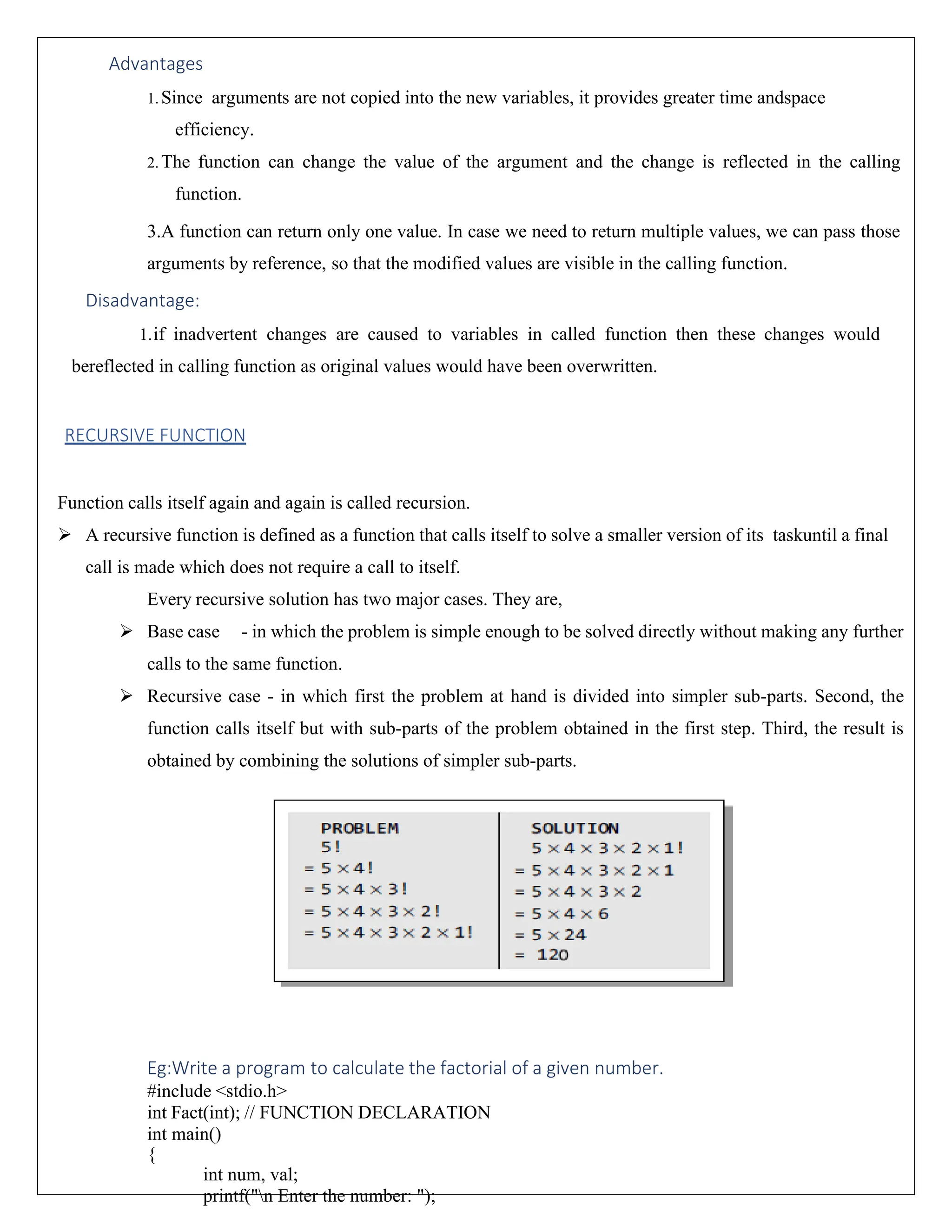
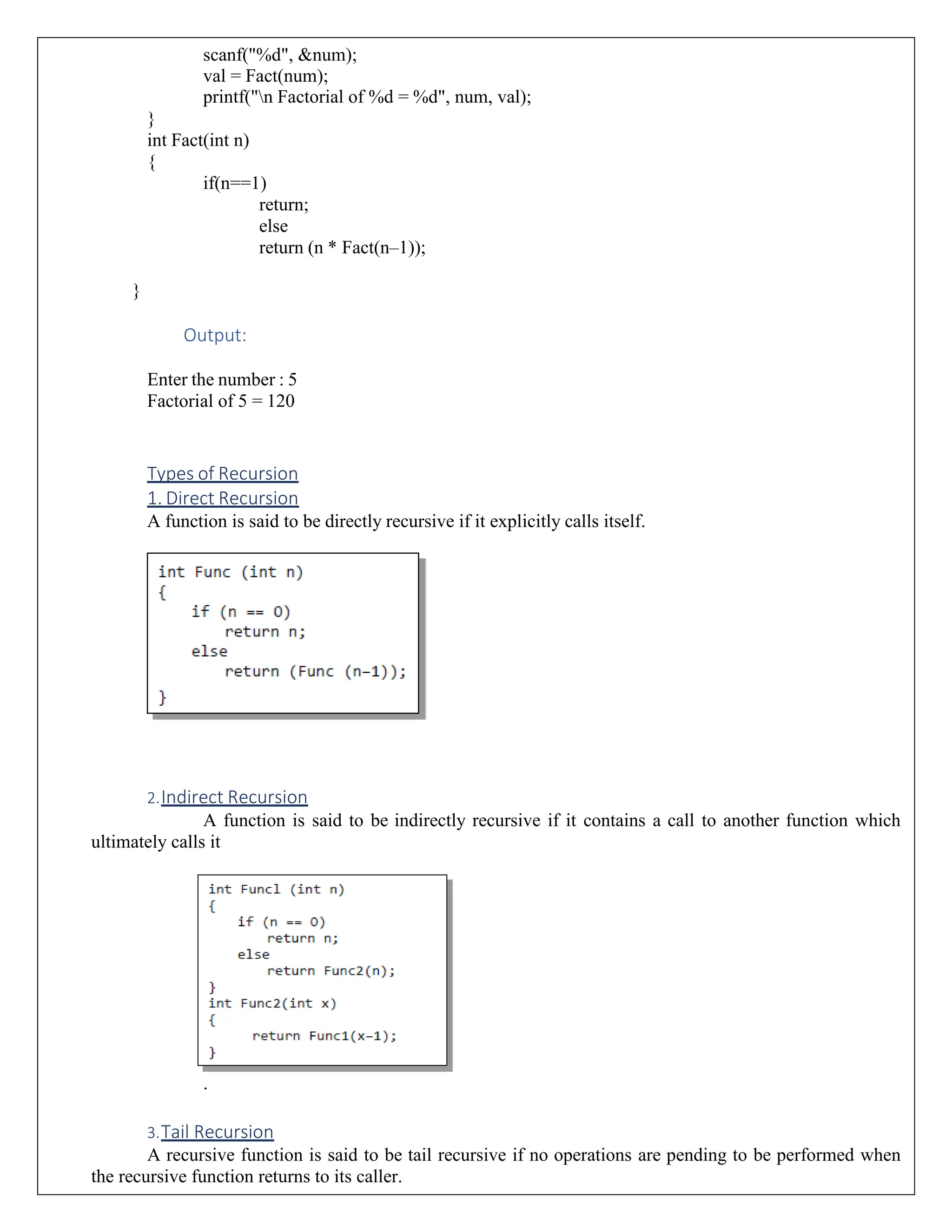
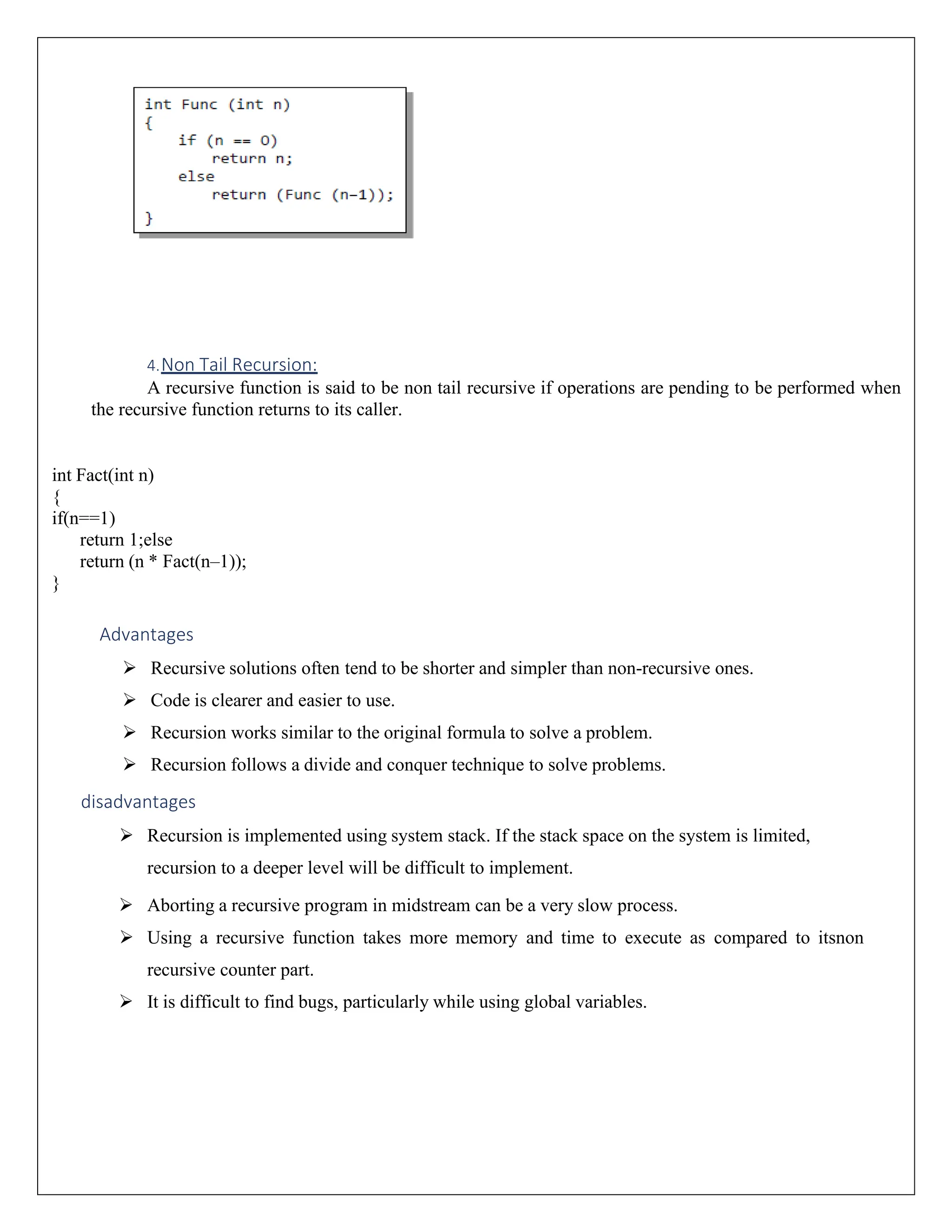
![PROGRAM TO DO BINARY SEARCH USING RECURSION #include<stdio.h> #define size 10 int binsearch(int[], int, int, int); int main() { int num, i, key, position; int low, high, list[size]; printf("nEnter the total number of elements"); scanf("%d", &num); printf("nEnter the elements of list :"); for (i = 0; i < num; i++) { scanf("%d", &list[i]); } low = 0; high = num - 1; printf("nEnter element to be searched : "); scanf("%d", &key); position = binsearch(list, key, low, high); if (position != -1) { } else printf("nNumber present at %d", (position + 1)); printf("n The number is not present in the list"); return (0); } // Binary Search function int binsearch(int a[], int x, int low, int high) { int mid; if (low > high) return -1; mid = (low + high) / 2; if (x == a[mid]) { return (mid); } else if (x < a[mid]) { binsearch(a, x, low, mid - 1); } else { binsearch(a, x, mid + 1, high); }](https://image.slidesharecdn.com/c-programming-241018114912-726c2e81/75/C-PROGRAMMING-pdf-text-book-notes-vtu-important-60-2048.jpg)

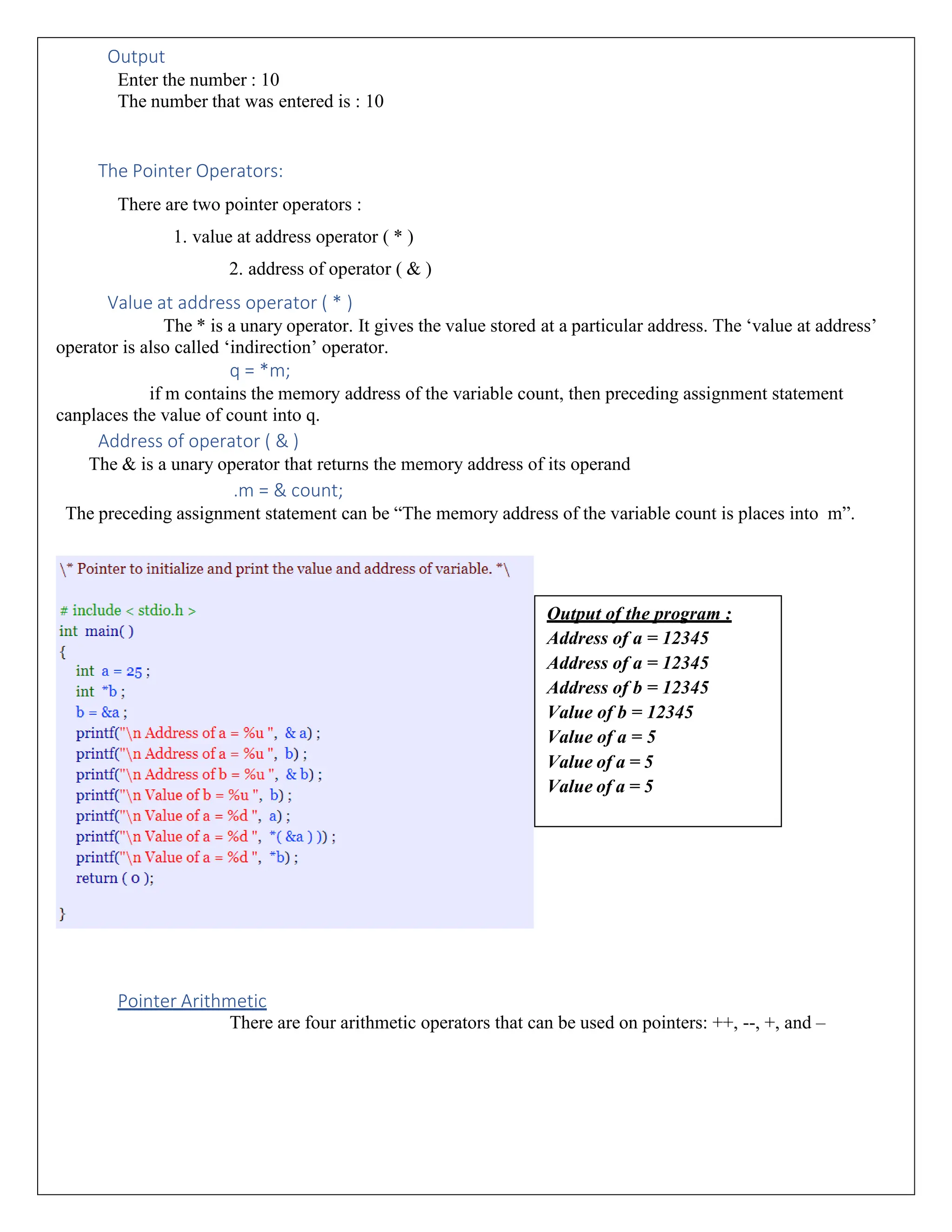
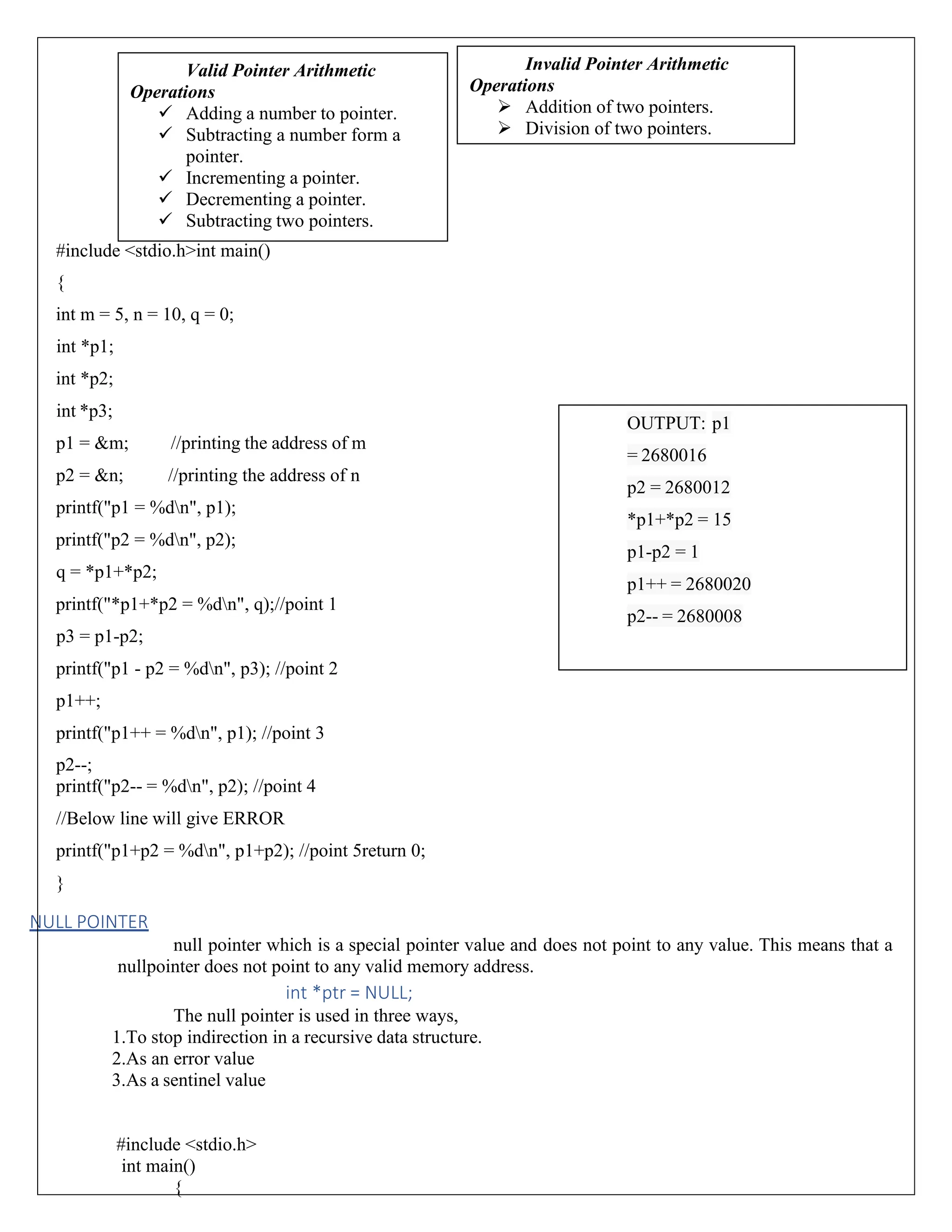
![int *ptr = NULL; printf("The value of ptr is %u",ptr); return 0; } Output : The value of ptr is 0 POINTERS AND ARRAYS : Syntax: int *ptr; ptr = &arr[0]; Here, ptr is made to point to the first element of the array. Eg:// program to display an array of given numbers. #include <stdio.h> int main() { int arr[]={1,2,3,4,5,6,7,8,9}; int *ptr1, *ptr2; ptr1 = arr; ptr2 = &arr[8]; while(ptr1<=ptr2) { printf("%d", *ptr1); ptr1++; } return 0; } ARRAY OF POINTERS: An array of pointers can be declared as. Eg:int *ptr[10]; The above statement declares an array of 10 pointers where each of the pointer points to aninteger variable. Example 2://Program on Array of Pointers int main() { datatype *array_name[size]; Output 1 2 3 4 5 6 7](https://image.slidesharecdn.com/c-programming-241018114912-726c2e81/75/C-PROGRAMMING-pdf-text-book-notes-vtu-important-64-2048.jpg)
![int *ptr[10]; int p = 1, q = 2, r = 3, s = 4, t = 5; ptr[0] = &p; ptr[1] = &q; ptr[2] = &r; ptr[3] = &s; ptr[4] = &t; printf("n %d", *ptr[3]); return 0; } Example 2://Program on Array of Pointers int main() { int arr1[]={1,2,3,4,5}; int arr2[]={0,2,4,6,8}; int arr3[]={1,3,5,7,9}; int *parr[3] = {arr1, arr2, arr3}; int i; for(i = 0;i<3;i++) printf(«%d», *parr[i]); return 0; } Applications of Pointers ➢ Pointers are used to pass information back and forth between functions. ➢ Pointers enable the programmers to return multiple data items from a function via function arguments. ➢ Pointers provide an alternate way to access the individual elements of an array. ➢ Pointers are used to pass arrays and strings as function arguments. ➢ Pointers are used to create complex data structures, such as trees, linked lists, linked stacks,linkedqueues, and graphs. PROGRAM TO SORT NAMES #include<stdio.h> #include<string.h> int main() { int i,j,count; char str[25][25],temp[25]; puts("How many strings u are going to enter?: "); Output 1 0 1 OUTPUT:4](https://image.slidesharecdn.com/c-programming-241018114912-726c2e81/75/C-PROGRAMMING-pdf-text-book-notes-vtu-important-65-2048.jpg)
![scanf("%d",&count); puts("Enter Strings one by one: "); for(i=0;i<=count;i++) gets(str[i]); for(i=0;i<=count;i++) for(j=i+1;j<=count;j++) strcpy(temp,str[i]); strcpy(str[i],str[j]); strcpy(str[j],temp); } } printf("Order of Sorted Strings:"); for(i=0;i<=count;i++) puts(str[i]); return 0; } 1. Write a program to calculate the GCD of two numbers using recursive functions.#include <stdio.h> int GCD(int, int); int main() { int num1, num2, res; printf("n Enter the two numbers: "); scanf("%d %d", &num1, &num2); res = GCD(num1, num2); printf("n GCD of %d and %d = %d", num1, num2, res); return 0; } int GCD(int x, int y) { int rem; rem = x%y; if(rem==0) return y; else return (GCD(y, rem)); }](https://image.slidesharecdn.com/c-programming-241018114912-726c2e81/75/C-PROGRAMMING-pdf-text-book-notes-vtu-important-66-2048.jpg)
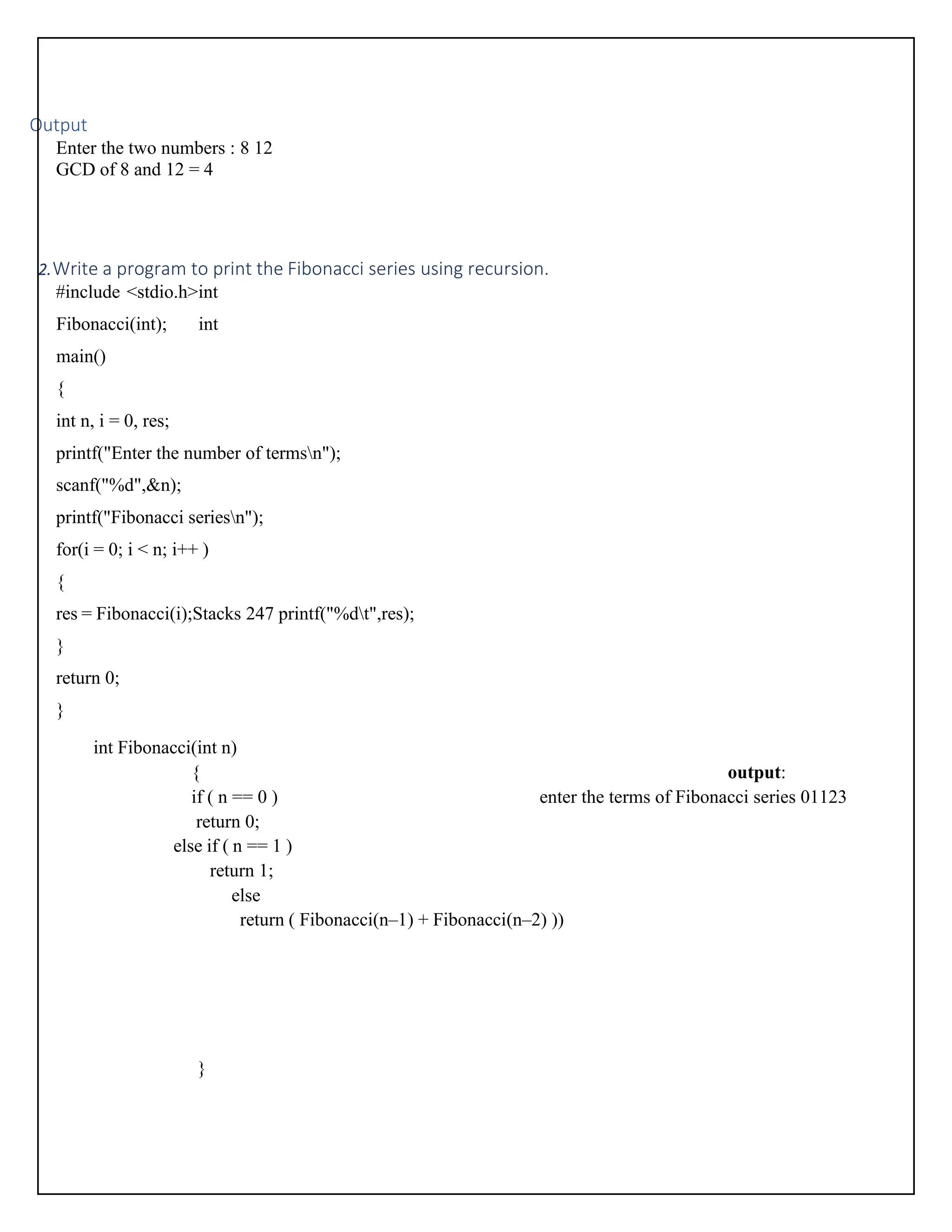
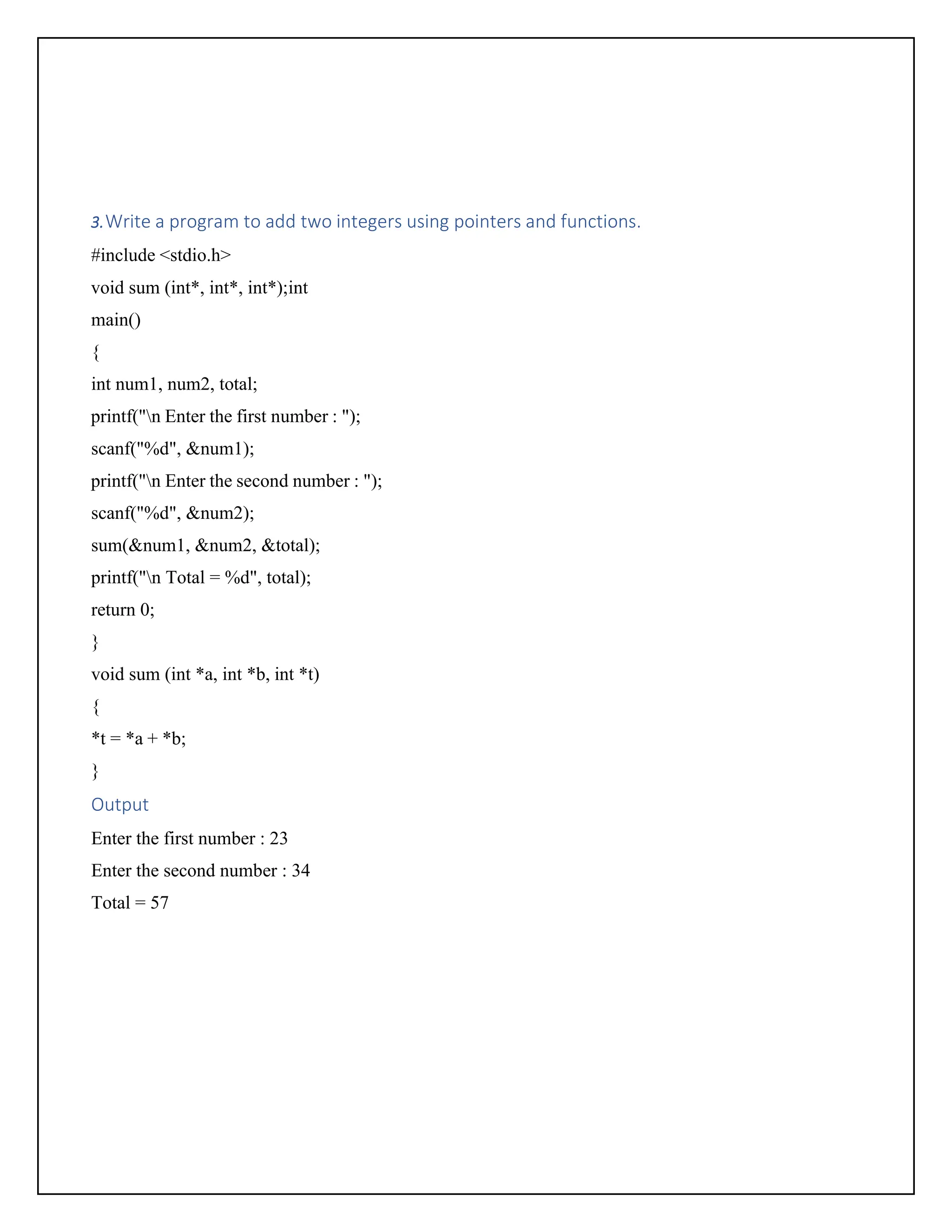
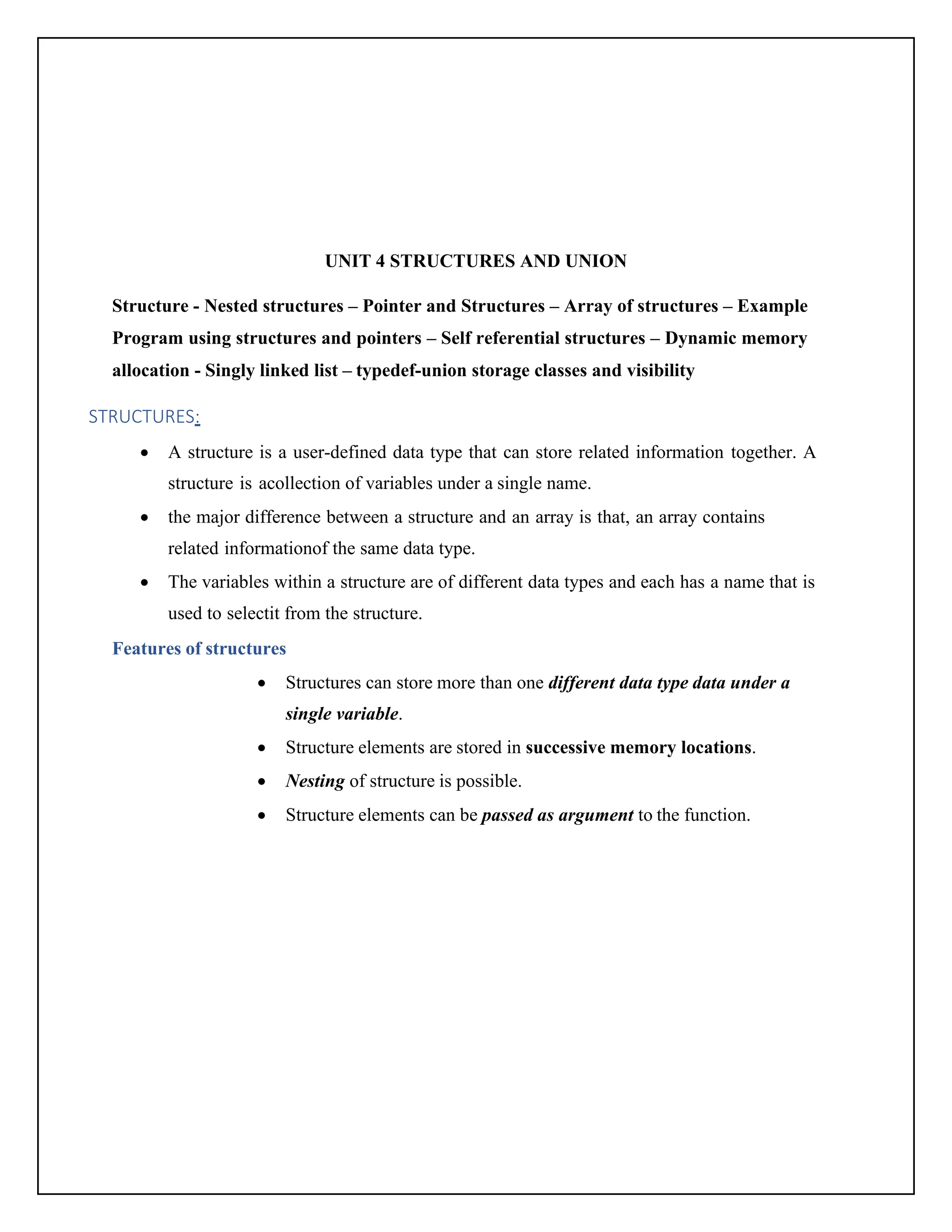


![{ int rno; char name[20]; char course[20]; float fees; }stud1={01,”Rahul”,”BCA”,45000}; or struct student stud2={02,”Rajiv”}; Fig. illustrates how the values will be assigned to individual fields of the structure Accessing the members of a structure: A structure member variable is generally accessed using a ‘.’(dot) operator. Syntax:](https://image.slidesharecdn.com/c-programming-241018114912-726c2e81/75/C-PROGRAMMING-pdf-text-book-notes-vtu-important-72-2048.jpg)
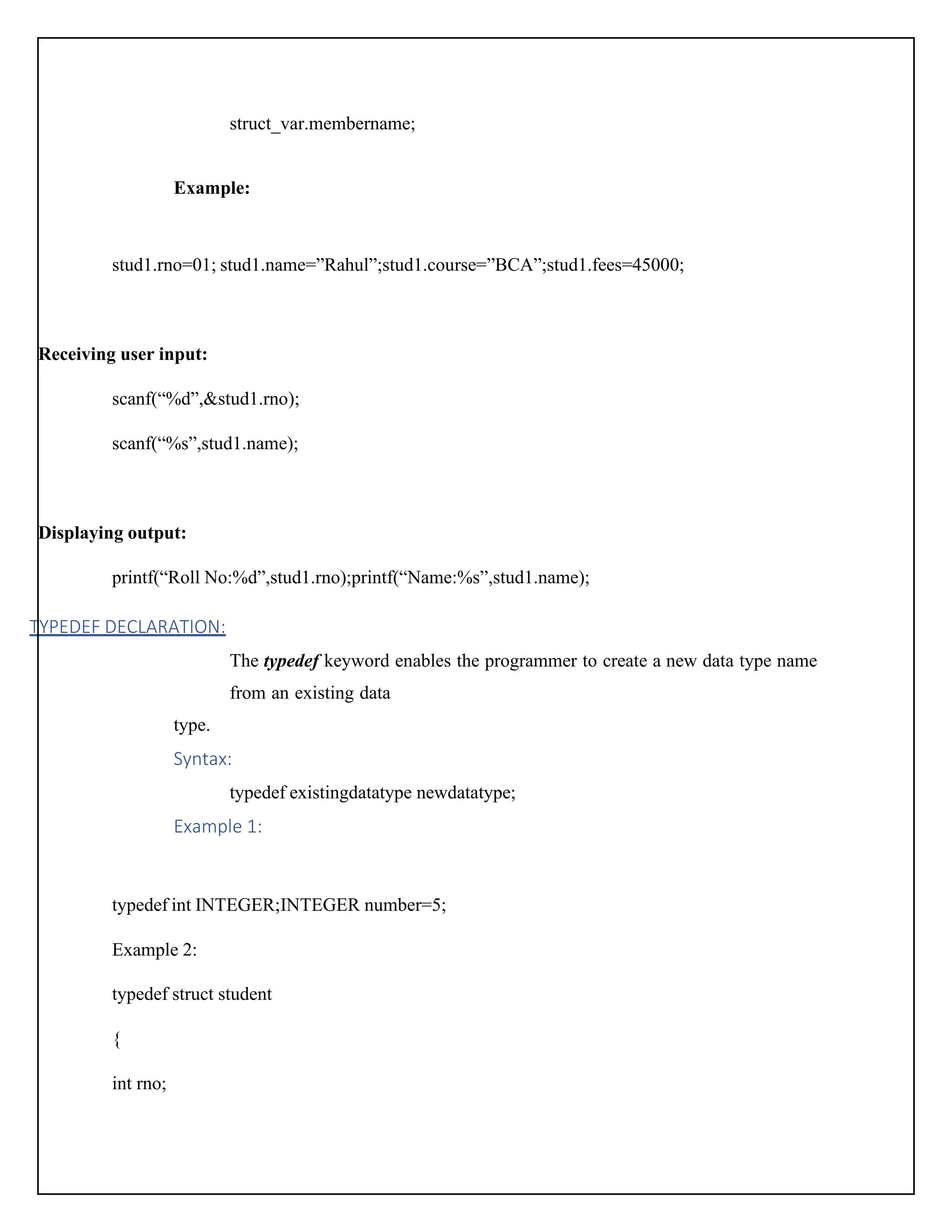
![char name[20]; char course[20];float fees; }; student s1; //instead of struct student s1; COPYING AND COMPARING STRUCTURES: Values of structure variables Copy We can assign a structure to another structure of the same type.struct student stud1={01,”Rahul”,”BCA”,45000}; struct student stud2=stud1; Compare: if(stud1.fees==stud2.fees) printf(“Fees of s2 and s1 are equal”);](https://image.slidesharecdn.com/c-programming-241018114912-726c2e81/75/C-PROGRAMMING-pdf-text-book-notes-vtu-important-74-2048.jpg)
![STRUCTURES WITHIN STRUCTURES (NESTED STRUCTURES) : • Structures can be placed within another structures ie., a structure may contain another structure as itsmember. A structure that contains another structure as its member is called as nested structures. Example:write a c program to read and display information of students using nested structure #include<stdio.h> int main() { int day; int month; int year; };struct student { int rollno; char no[100]; float fees; struct DOB date; }; struct student stud1; clrscr(); printf(“enter the roll no”); scanf(“%d”,&stud1.roll_no); printf(“enter the name”); scanf(“%s”,stud1.name); printf(“enter the fees”); scanf(“%f “,&stud1.fees); printf(“enter the DOB”); printf(“%d%d%d”,&stud1.date.day,&stud1.date.month,&stud1.date.year); Printf(“n ******students details******”);](https://image.slidesharecdn.com/c-programming-241018114912-726c2e81/75/C-PROGRAMMING-pdf-text-book-notes-vtu-important-75-2048.jpg)
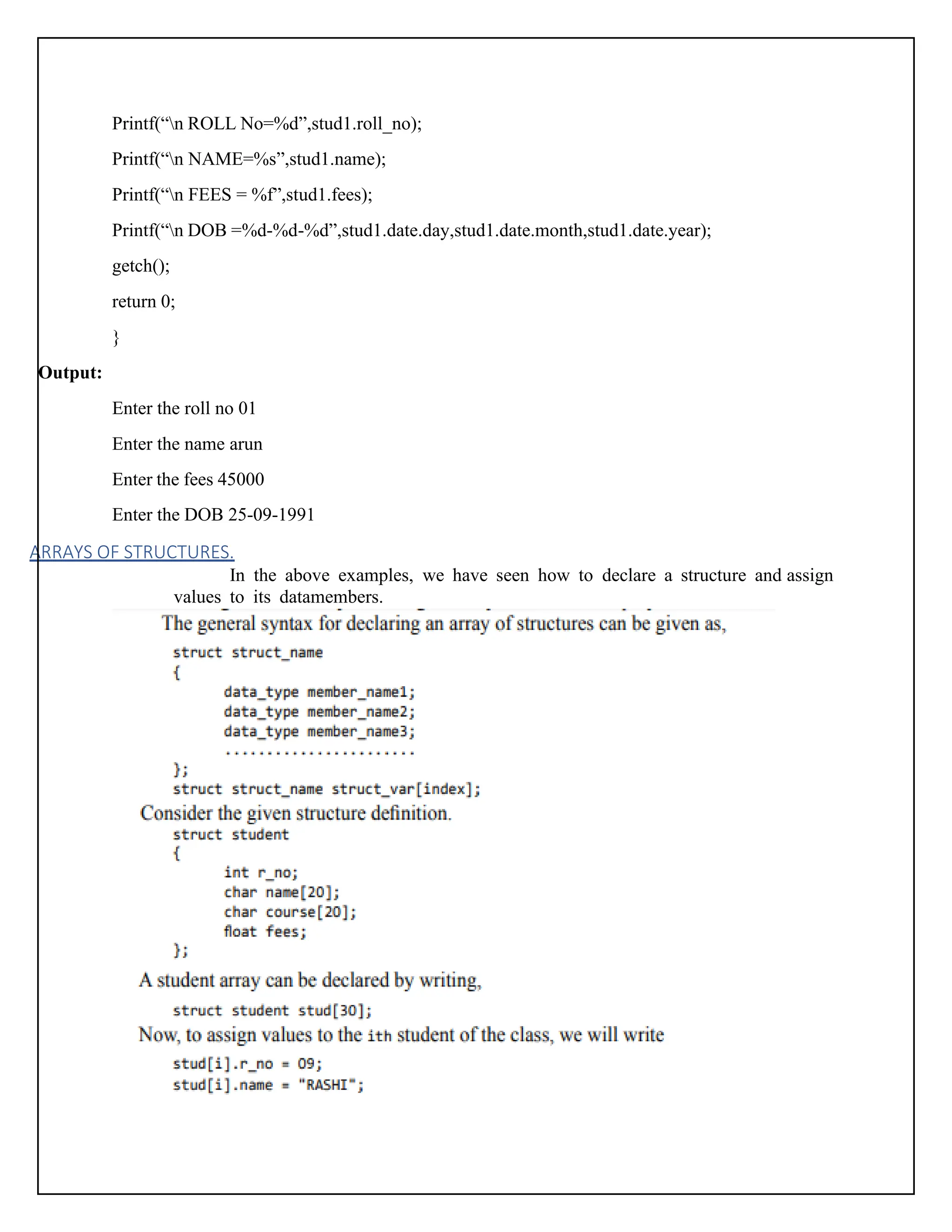


![" ) ; • For our student structure, we can declare a pointer variable by writing • • • The next thing to do is to assign the address of stud to the pointer using the address operator(&), as we would do in case of any other pointer. So to assign the address, we will write • • To access the members of a structure, we can write Write a program to initialize the members of a structure by using a pointer to thestructure. #include<stdio.h> #include <conio.h> struct student { int r_no; char name[20]; char course[20]; int fees; }; int main() { struct student stud1, *ptr_stud1; clrscr(); ptr_stud1 = &stud1; printf("n Enter the details of the student : printf("n Enter the Roll Number ="); scanf("%d", &ptr_stud1 -> r_no); printf("n Enter the Name = ); gets(ptr_stud1 -> name); printf("n Enter the Course = "); gets(ptr_stud1 -> course); Output Enter the details of the student: Enter the RollNumber = 02 Enter the Name = Aditya Enter the Course = MCA Enter the Fees = 60000 DETAILS OF THE STUDENT ptr_stud = &stud; struct student *ptr_stud, stud; (*ptr_stud).roll_no;](https://image.slidesharecdn.com/c-programming-241018114912-726c2e81/75/C-PROGRAMMING-pdf-text-book-notes-vtu-important-79-2048.jpg)

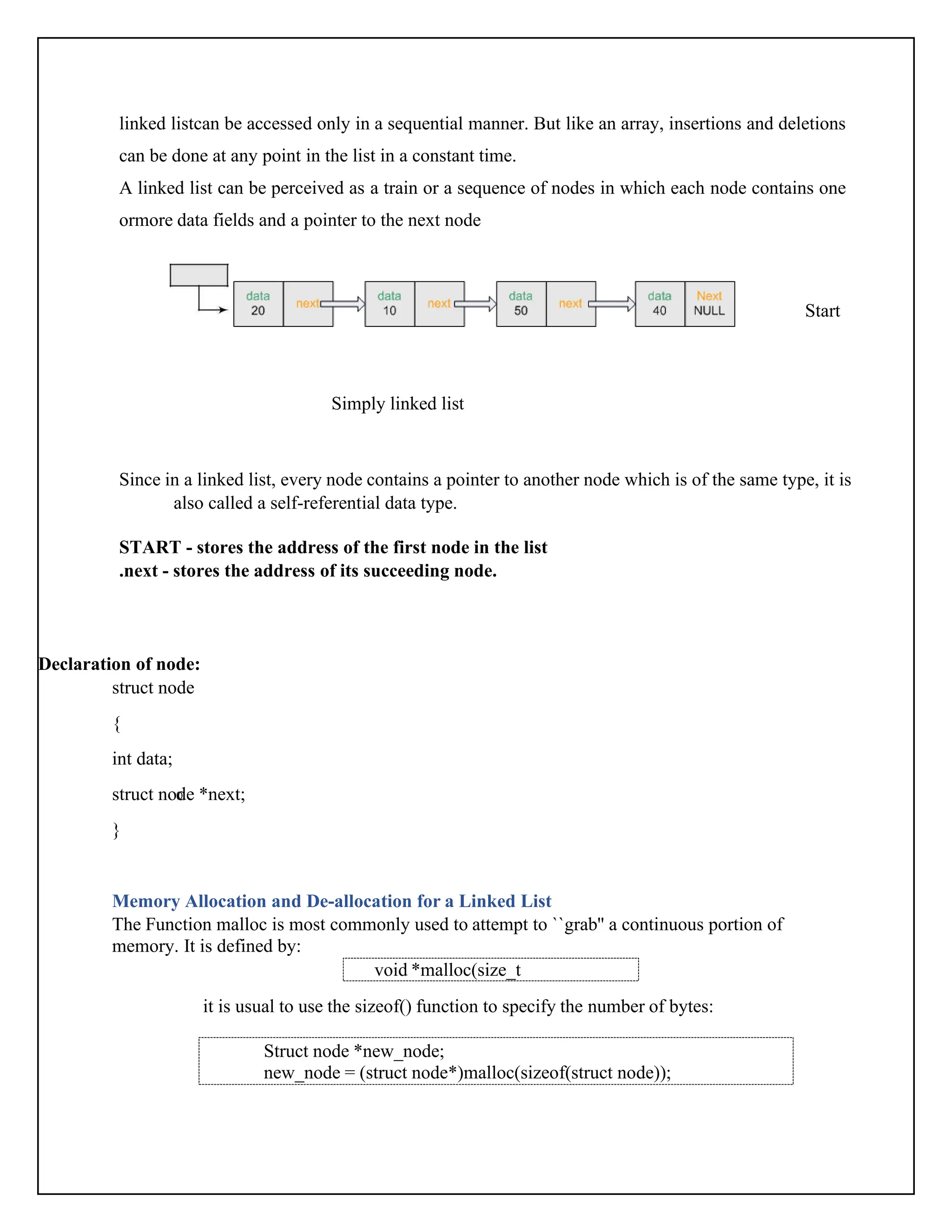

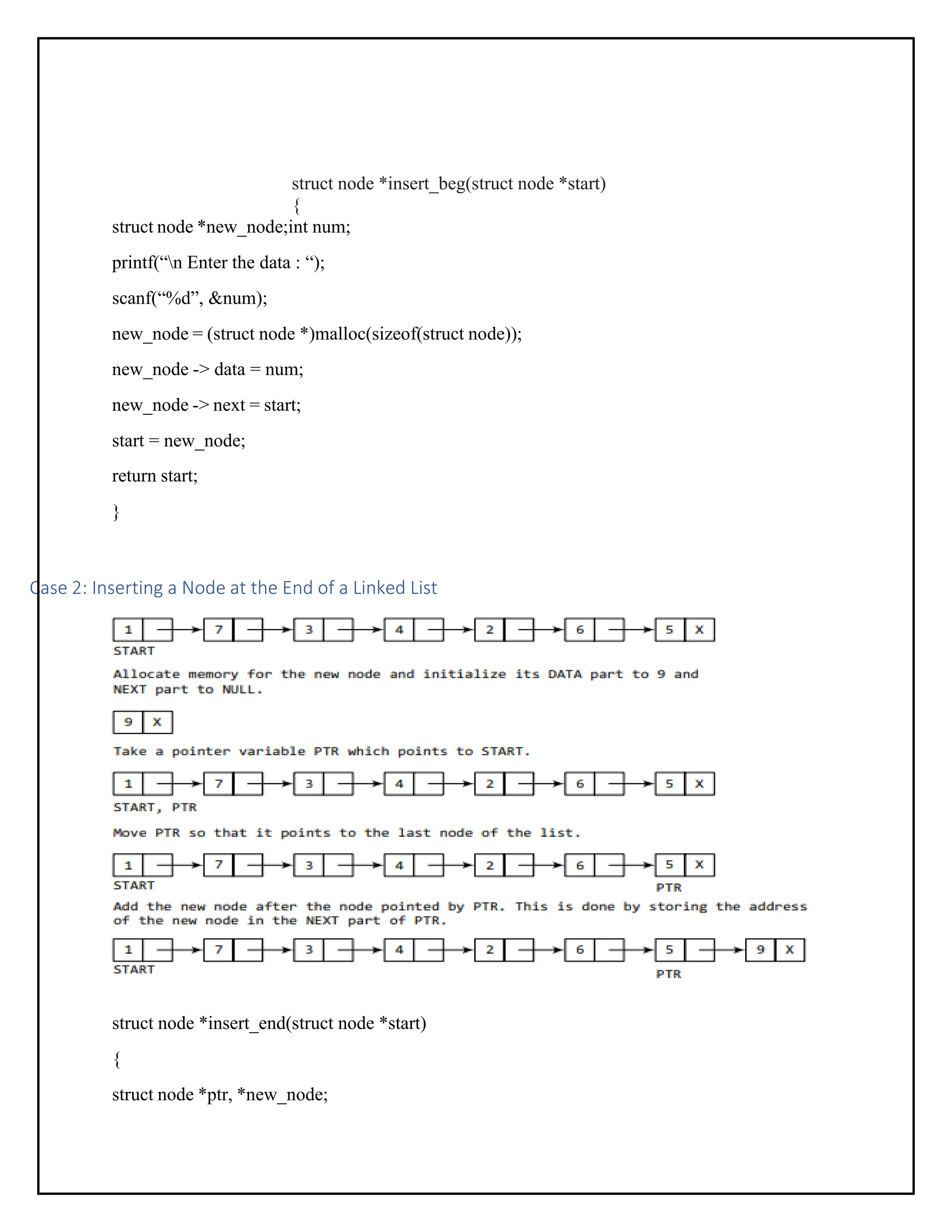

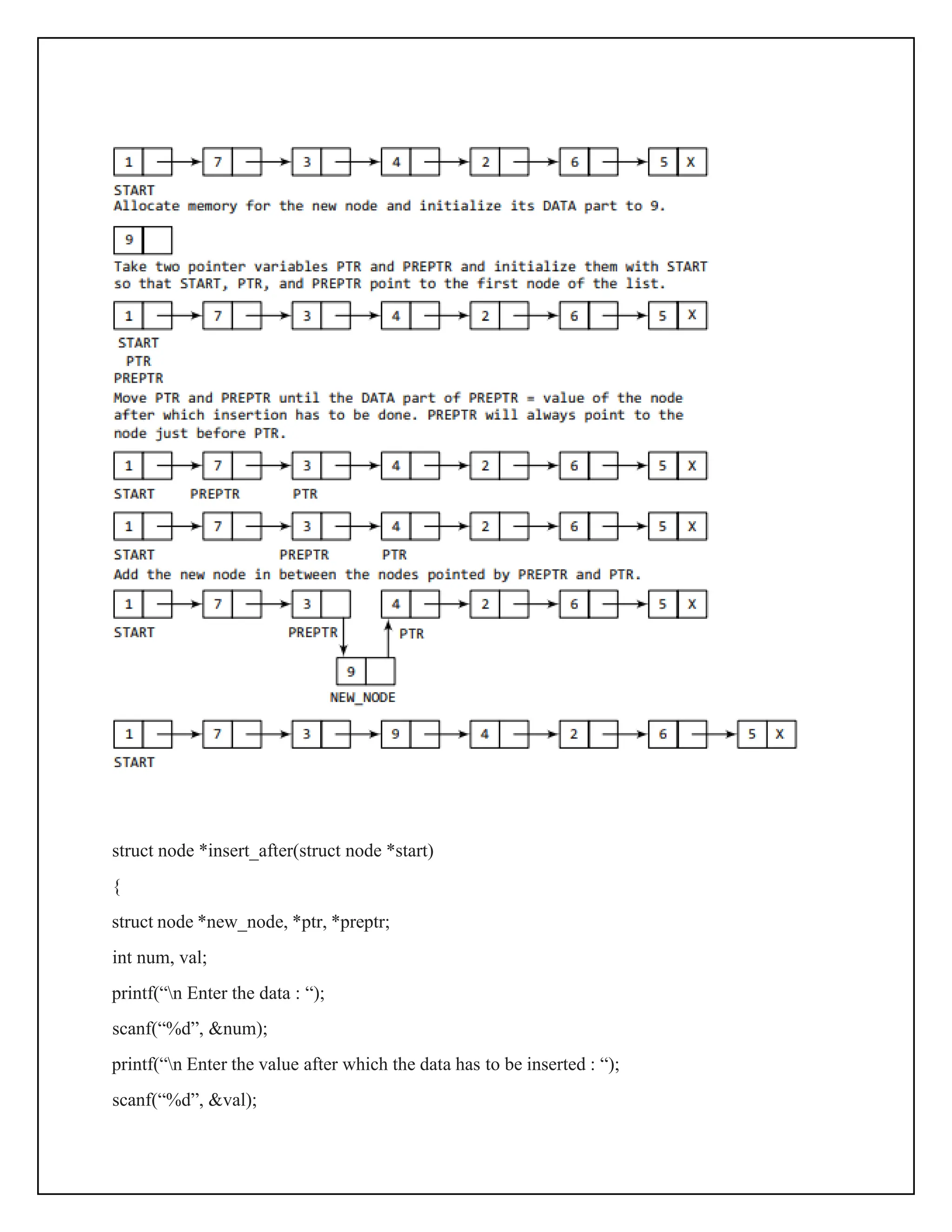
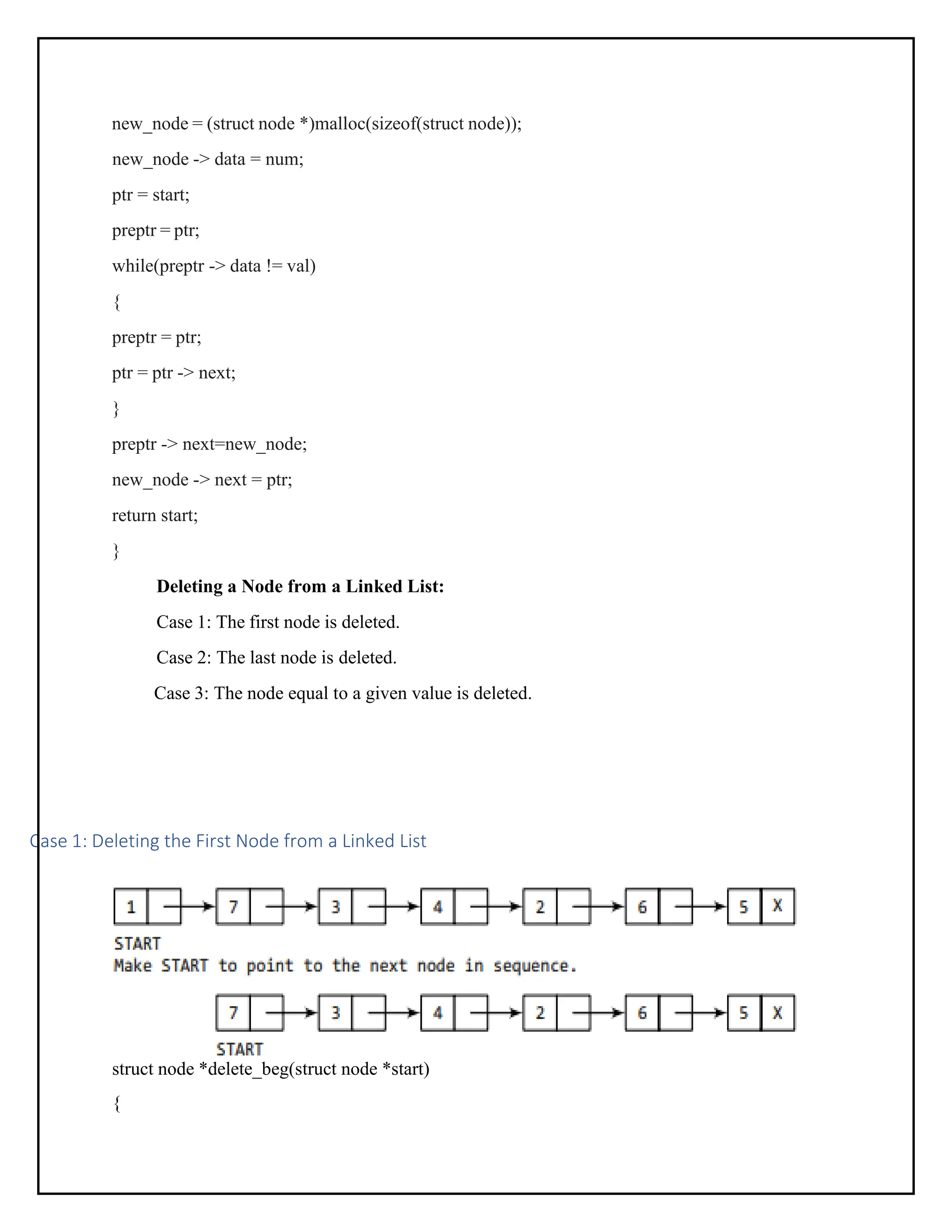


![start = delete_beg(start); return start; while(ptr -> data != val) { preptr = ptr; ptr = ptr -> next; } preptr -> next = ptr -> next; free(ptr); return start; } } } else { Programming Example Declare a structure to store information of a particular date. struct date { int day; int month; int year; }; Declare a structure to create an inventory record. struct inventory { char prod_name[20]; float price; int stock;](https://image.slidesharecdn.com/c-programming-241018114912-726c2e81/75/C-PROGRAMMING-pdf-text-book-notes-vtu-important-89-2048.jpg)
![}; Write a program, using an array of pointers to a structure, to read and display the data of students. #include <stdio.h> #include <conio.h> #include <alloc.h> struct student { int r_no; char name[20]; char course[20]; int fees; }; struct student *ptr_stud[10]; int main() { int i, n; printf("n Enter the number of students : "); scanf("%d", &n); for(i=0;i<n;i++) { ptr_stud[i] = (struct student *)malloc(sizeof(struct student)); printf("nEnter the data for student %d ", i+1);](https://image.slidesharecdn.com/c-programming-241018114912-726c2e81/75/C-PROGRAMMING-pdf-text-book-notes-vtu-important-90-2048.jpg)
![printf("n ROLL NO.: "); scanf("%d", &ptr_stud[i]–>r_no); printf("n NAME: "); gets(ptr_stud[i]->name); printf(“ncourse”); gets(ptr->stud[i]->course); printf(“/n FEES”); scanf(“%d”,&ptr_stud[i]->fees); } printf(“n DETAILS OF STUDENT”); for(i=0;i<n;i++) { printf((“n ROLL NO=%d”,ptr.stud[i]->r.no); printf(“n NAME=%s,ptr->stud[i]->name); printf(“n COURSE=%s,ptr->stud[i]->course); printf(“n FEES=%d”,ptr->stud[i]->fees); } return 0; } Output Enter the number ofstudents : 1 Enter the data forstudent 1 ROLL NO.: 01 NAME: Rahul COURSE:BCA FEES: 45000 DETAILS OF STUDENT](https://image.slidesharecdn.com/c-programming-241018114912-726c2e81/75/C-PROGRAMMING-pdf-text-book-notes-vtu-important-91-2048.jpg)
![SROLL NO. = 01 NAME = Rahul COURSE = BCA FEES = 45000 Write a program that passes a pointer to a structure to a function. #include <stdio.h> #include <conio.h> #include <alloc.h> struct student { int r_no; char name[20]; char course[20]; int fees; }; void display (struct student *); int main() { struct student *ptr; ptr = (struct student *)malloc(sizeof(struct student)); printf("n Enter the data for the student "); printf("n ROLL NO.: "); scanf("%d", &ptr–>r_no); printf("n NAME: "); gets(ptr–>name); printf("n COURSE: "); gets(ptr–>course);](https://image.slidesharecdn.com/c-programming-241018114912-726c2e81/75/C-PROGRAMMING-pdf-text-book-notes-vtu-important-92-2048.jpg)


